Westell PSA41080-VHF Bi-Directional Amplifier User Manual Part 1
Westell, Inc. Bi-Directional Amplifier Part 1
Westell >
Contents
- 1. User Manual_Part 1
- 2. User Manual_Part 2
- 3. User Manual_Part 3
User Manual_Part 1
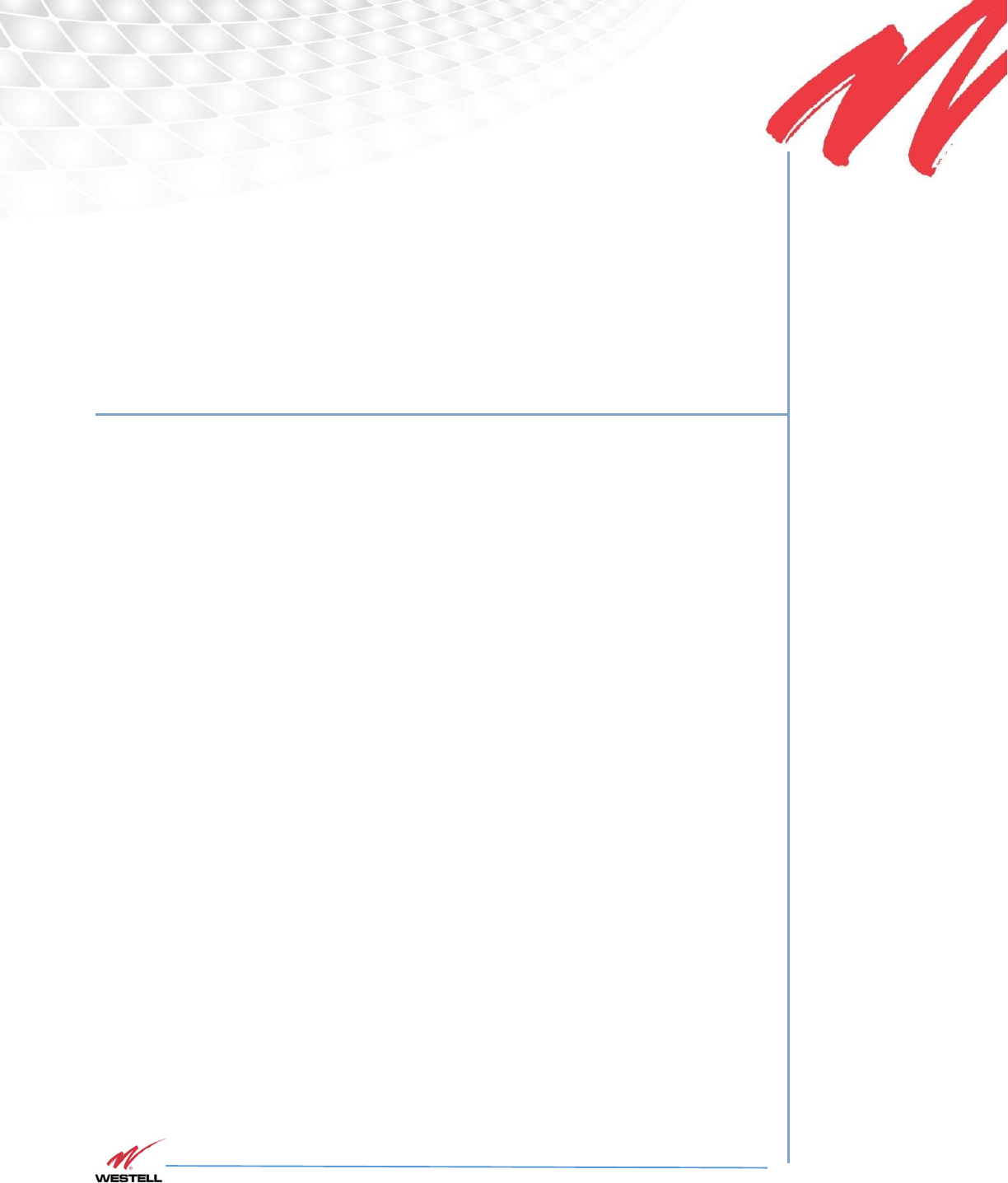
VHF Product Manual
July 2018, Rev B
WESTELL.COM
©2017 Westell Technologies July 2018; Doc No. VHF Signal Booster UM RA
1.877.844.4274 Page 1 of 95
5689
VHF 1/4W Public Safety Signal Booster
Users Guide
PRODUCT MANUAL
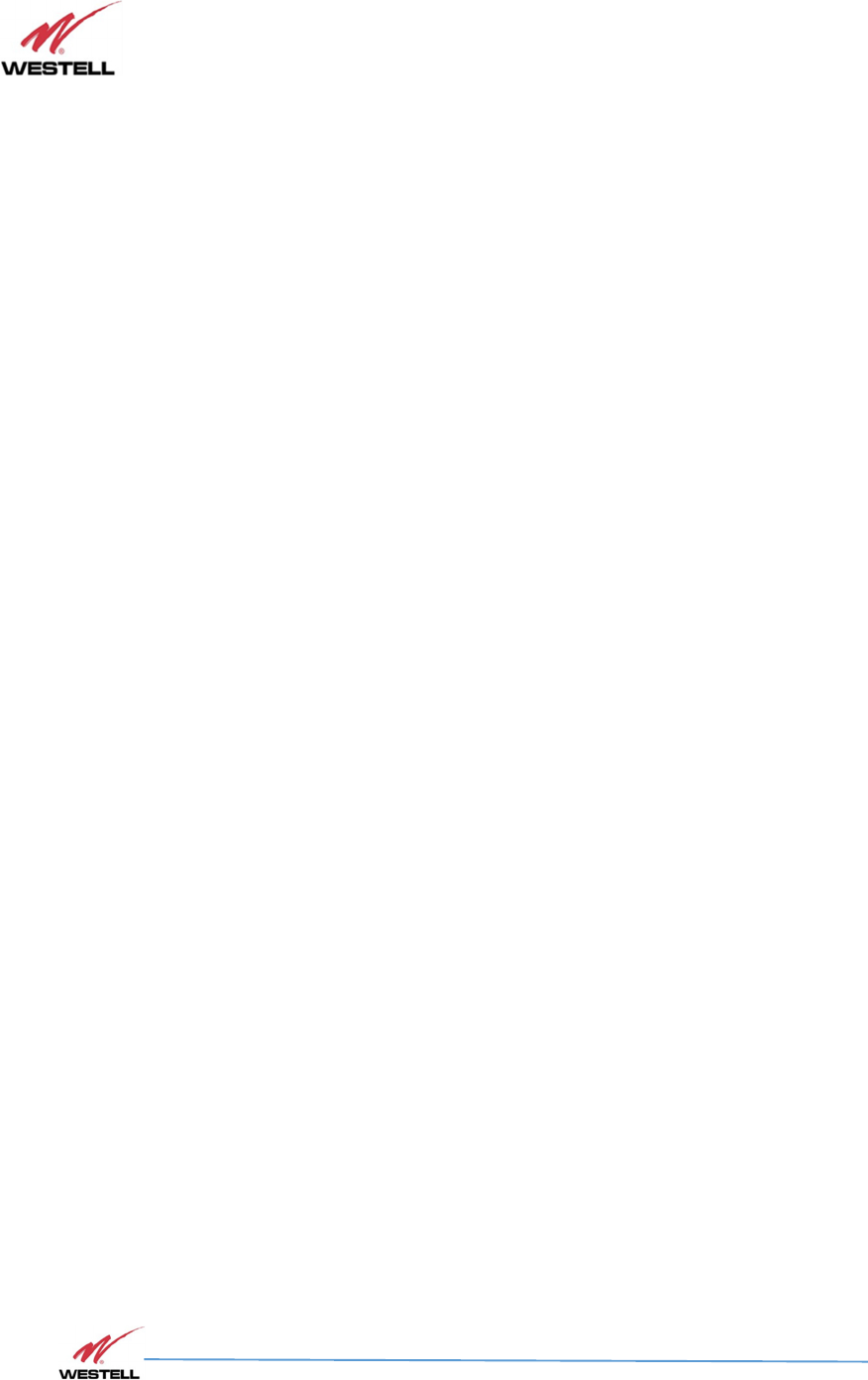
VHF Product Manual
July 2018, Rev B
WESTELL.COM
©2017 Westell Technologies July 2018; Doc No. VHF Signal Booster UM RA
1.877.844.4274 Page 2 of 95
DISCLAIMER
All information and statements contained herein are accurate to the best of Westell
Technologies knowledge. Westell makes no warranty with respect there to, including
without limitation any results that may be obtained from the products described herein or
the infringement by such products of any property rights of any persons. Use or application
of such information or statements is at the users’ sole risk, without any liability on the part
of Westell. Nothing herein shall be construed as license or recommendation for use, which
infringes upon any propriety rights of any person. Product material and specifications are
subject to change without notice. Westell standard terms of sale and the specific terms of
any particular sale apply.
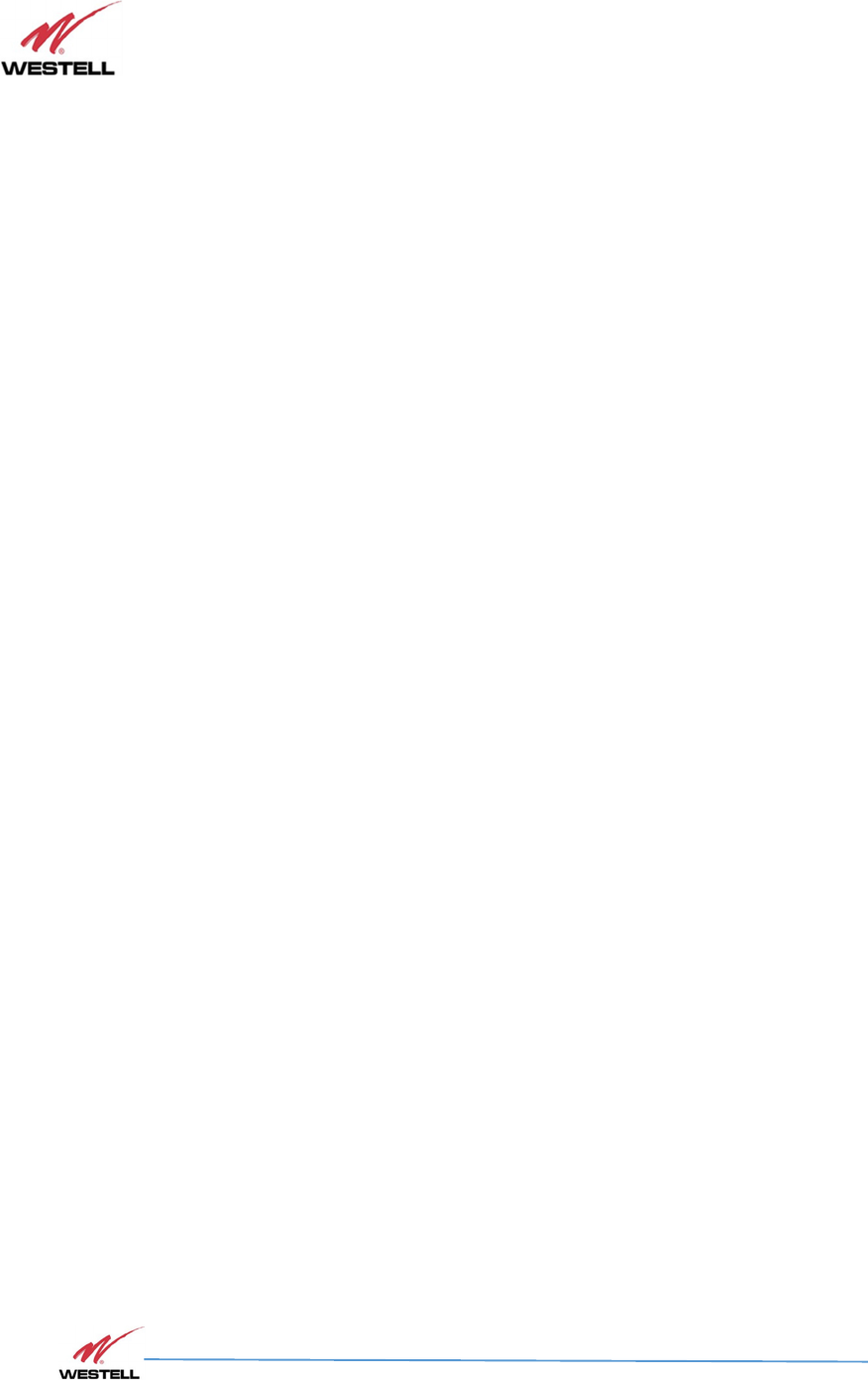
VHF Product Manual
July 2018, Rev B
WESTELL.COM
©2017 Westell Technologies July 2018; Doc No. VHF Signal Booster UM RA
1.877.844.4274 Page 3 of 95
Table of Contents
PREFACE................................................................................................................................... 7
Purpose ............................................................................................................................................................. 7
Scope................................................................................................................................................................. 7
Audience ........................................................................................................................................................... 7
Document Organization ................................................................................................................................ 8
References ........................................................................................................................................................ 9
Document Conventions ................................................................................................................................. 9
Safety Notices ............................................................................................................................................... 10
Technical Support ......................................................................................................................................... 10
Acronyms and Abbreviations ..................................................................................................................... 10
Copyright and Trademark Acknowledgements ...................................................................................... 10
1 GENERAL INFORMATION ............................................................................................... 11
1.1 Document Purpose and Intended Users .......................................................................................... 11
1.2 Application ............................................................................................................................................. 11
1.2.1 Product Registration Information ........................................................................................................................ 11
1.3 Safety Guidelines .................................................................................................................................... 12
1.3.1 Important Safety Information ..................................................................................................................................... 13
1.4 FCC Part 90 Signal Boosters ................................................................................................................ 13
1.5 FCC Contact Information ...................................................................................................................... 15
2 PRODUCT OVERVIEW
...................................................................................................................... 16
2.1 Product Information .............................................................................................................................. 16
2.2 Product Features .................................................................................................................................... 17
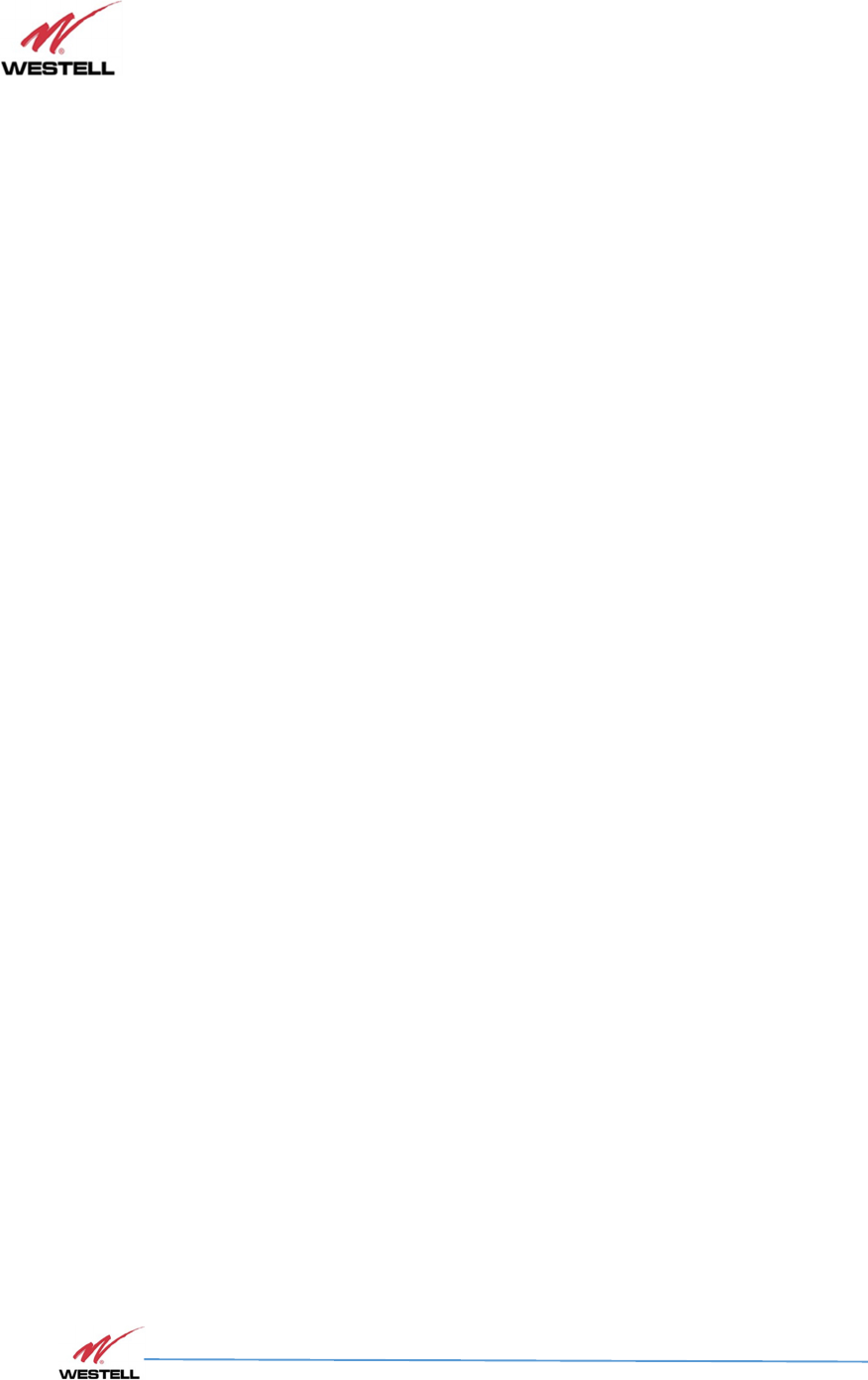
VHF Product Manual
July 2018, Rev B
WESTELL.COM
©2017 Westell Technologies July 2018; Doc No. VHF Signal Booster UM RA
1.877.844.4274 Page 4 of 95
2.3
Included Accessories............................................................................................................................. 17
2.4 Optional Accessories ............................................................................................................................. 19
3 PRODUCT SPECIFICATION .............................................................................................. 18
3.1 RF Specifications .................................................................................................................................... 18
3.2 Power Specification ............................................................................. Error! Bookmark not defined.18
3.3 Mechanical Specification .................................................................... Error! Bookmark not defined.18
4 PRODUCT APPEARANCE....................................... ERROR! BOOKMARK NOT DEFINED.
4.1 External Configuration ............................................................................ Error! Bookmark not defined.
5 INSTALLATION GUIDELINES ............................. ERROR! BOOKMARK NOT DEFINED.22
5.1 Important Installation Guidelines ..................................................... Error! Bookmark not defined.22
5.2 Donor Antenna Installation Guidelines ........................................... Error! Bookmark not defined.23
5.3 Indoor Antenna Installation Guidelines ........................................... Error! Bookmark not defined.23
5.4 Mounting the Signal Booster ............................................................ Error! Bookmark not defined.24
6 CONNECTING THE SIGNAL BOOSTER ........... ERROR! BOOKMARK NOT DEFINED.36
6.1 Connecting Step-By-Step .................................................................... Error! Bookmark not defined.36
7.0 SYSTEM OPERATION .................................................................................................... 38
8.0 STATUS INDICATORS.................................................................................................... 43
9.0 SOFTWARE ..................................................................................................................... 45
9.1 Introduction………………………………………………………………………………………………………………………… Error!
Bookmark not defined.45
9.2 Local Software…………………………………………………………………………………………………………………………Error!
Bookmark not defined.45
10.0 REMOTE WEB SERVER OPTION ................................................................... 51
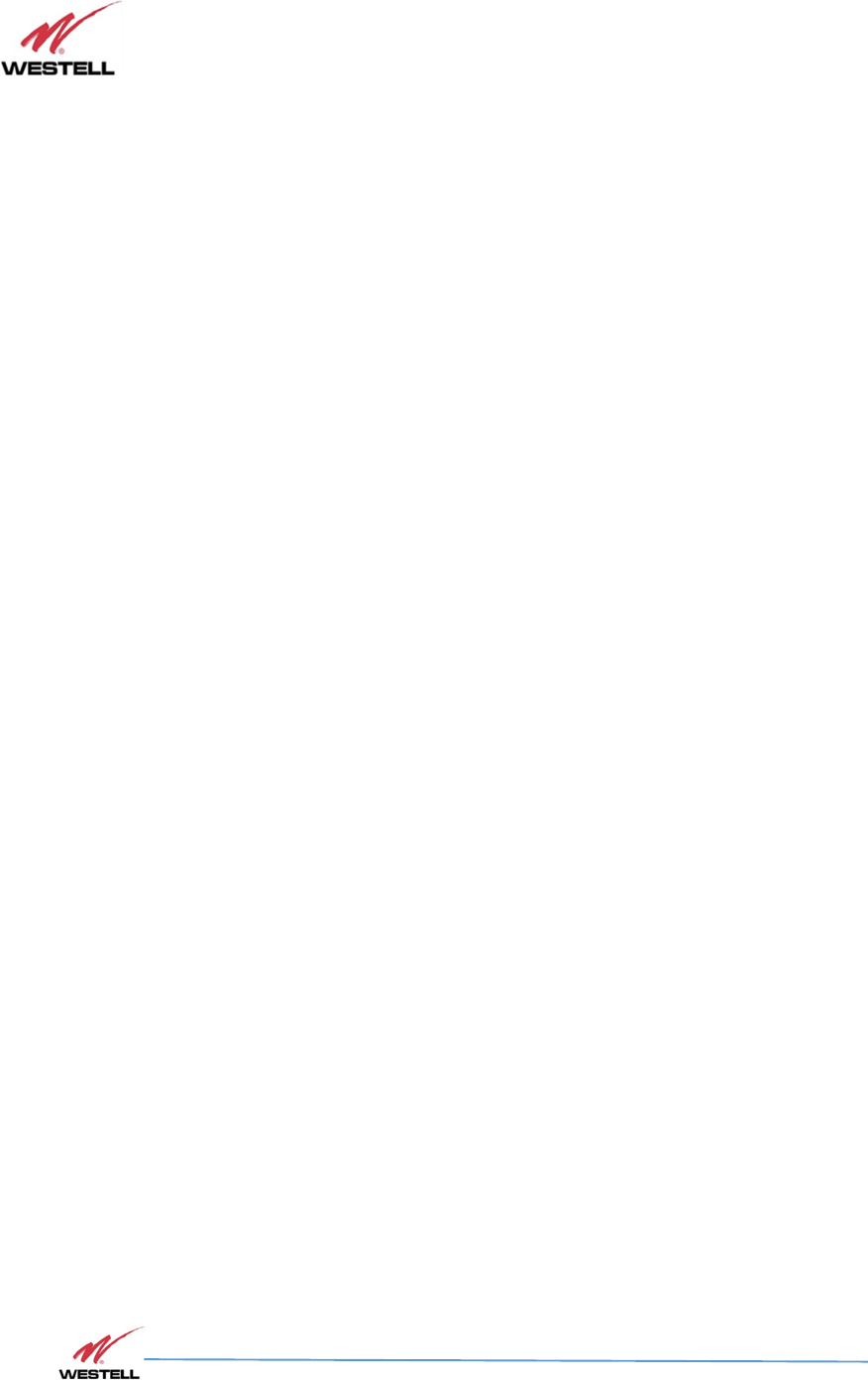
VHF Product Manual
July 2018, Rev B
WESTELL.COM
©2017 Westell Technologies July 2018; Doc No. VHF Signal Booster UM RA
1.877.844.4274 Page 5 of 95
10.1 Introduction………………………………………………………………………………………………………………………… Error!
Bookmark not defined.51
10.2 Webpage Description………………………………………………………………………………………………………… Error!
Bookmark not defined.52
11.0 RF PARAMETER DESCRIPTIONS .............................................................................. 62
12.0 SPECTRUM ANALYZER .............................................................................................. 70
13.0 SNMP AGENT .............................................................................................................. 73
14.0 SNMP TRAPS ............................................................................................................... 83
APPENDIX A IMPORTANT PRODUCT INFORMATION .............................................. 94
A.1 Registration Number............................................................................................................................. 94
A.2 UL .............................................................................................................................................................. 94
APPENDIX B ACRONYMS AND ABBREVIATIONS ...................................................... 95
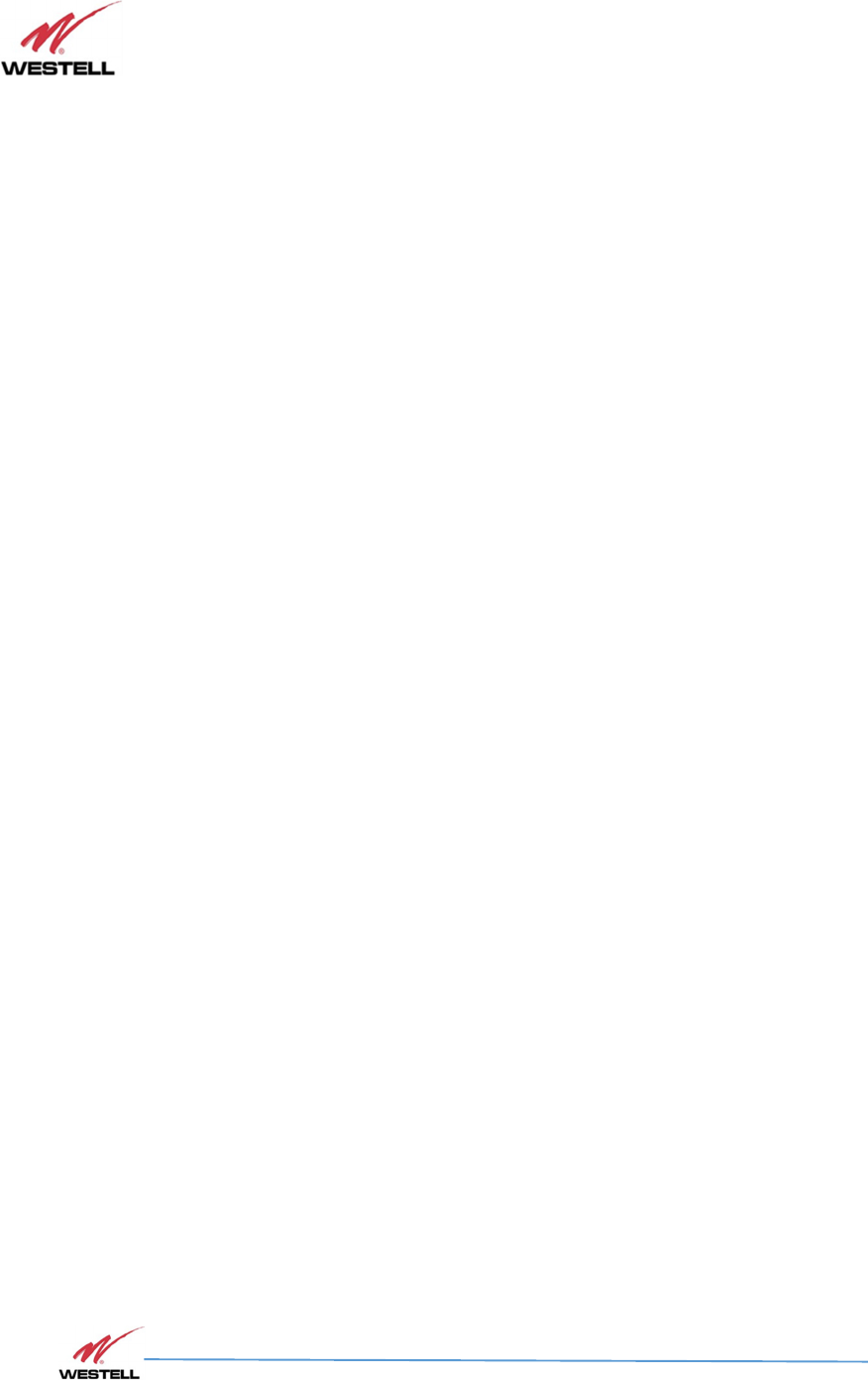
VHF Product Manual
July 2018, Rev B
WESTELL.COM
©2017 Westell Technologies July 2018; Doc No. VHF Signal Booster UM RA
1.877.844.4274 Page 6 of 95
INTENTIONALLY BLANK
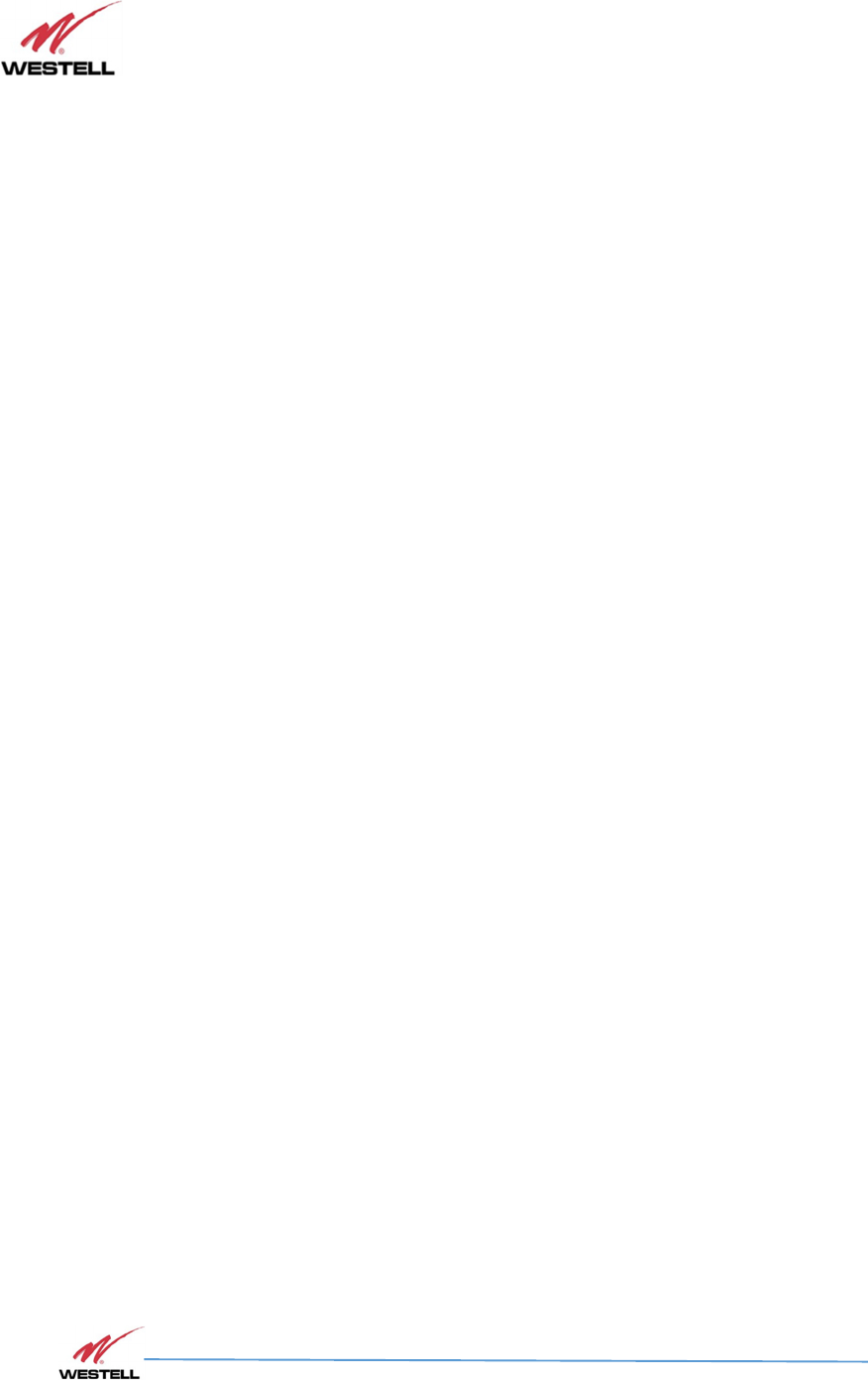
VHF Product Manual
July 2018, Rev B
WESTELL.COM
©2017 Westell Technologies July 2018; Doc No. VHF Signal Booster UM RA
1.877.844.4274 Page 7 of 95
Preface
This Preface includes the following:
• Purpose
• Scope
• Audience
• Document Organization
• References
• Document Conventions
• Safety Notices
• Technical Support
• Acronyms and Abbreviations
• Copyright and Trademark Acknowledgements
Purpose
This manual contains information and procedures for the operation of the Westell VHF Public Safety
Signal Booster.
Changes that occur after the publishing date may be incorporated by a complete manual revision or
as additions.
Scope
Reference this manual when there is a need to add enhanced signal capability to a new or existing
system, to monitor a system, make maintenance adjustments, or address alarms.
Audience
This manual is intended for installers and users who are familiar with similar types of equipment.
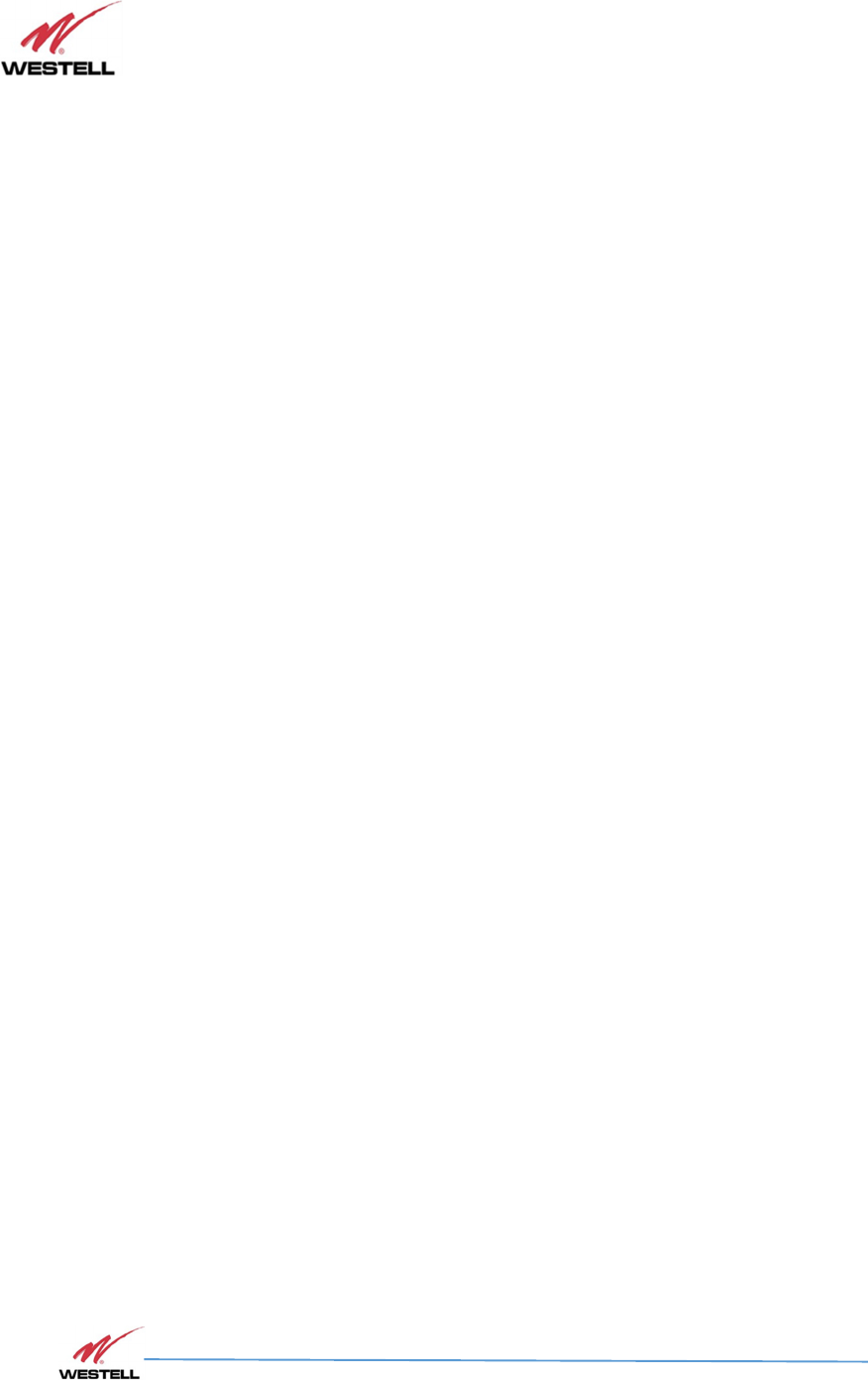
VHF Product Manual
July 2018, Rev B
WESTELL.COM
©2017 Westell Technologies July 2018; Doc No. VHF Signal Booster UM RA
1.877.844.4274 Page 8 of 95
Document Organization
This manual includes the following chapters:
•
Chapter 1: General Information – Outlines the document purpose and intended users,
application, product registration, safety guidelines, disclaimer and FCC Part 90, FCC Warning
Labels.
•
Chapter 2: Product Overview – Provides product information, describes product features
and lists accessories.
•
Chapter 3: Product Specification – Provides tables containing RF, power, mechanical and
environmental specifications. Also provides information about GUI items, alarm status and
alarm relay.
•
Chapter 4: Product Appearance – Provides physical specifications, photographs and
information about the external and internal Signal Booster configuration.
•
Chapter 5: Installation Guidelines – Lists guidelines for installing the Signal Booster and
antennas.
•
Chapter 6: Connecting the Signal Booster – Provides guidelines on connecting the signal
booster to power, antennas, etc.
•
Chapter 7: System Operation – Describes product operation, including how to open the
communication port and describes the functions in the Status and Control pages.
•
Chapter 8: Status Indicators – Outlines the LEDs status lights on the signal booster.
•
Chapter 9: Software Installation – Outlines the steps required to install the software.
•
Chapter 10: Remote Web Server Option – Outlines the steps required to connect remotely.
•
Chapter 11: RF Parameters – Outlines the signal booster’s RF parameters in the GUI.
•
Chapter 12: Spectrum Analyzer – Outlines the steps required to use the imbedded spectrum
analyzer.
•
Chapter 13: SNMP Agent – Outlines the steps required to use the SNMP Agent.
•
Chapter 14: SNMP Traps – Outlines the traps for the SNMP Agent.
•
Appendix A: Important Product Information – Provides the product registration number
and internal power supply information.
•
Appendix B: Acronyms and Abbreviations – A table of acronyms and abbreviations and
definitions for each.
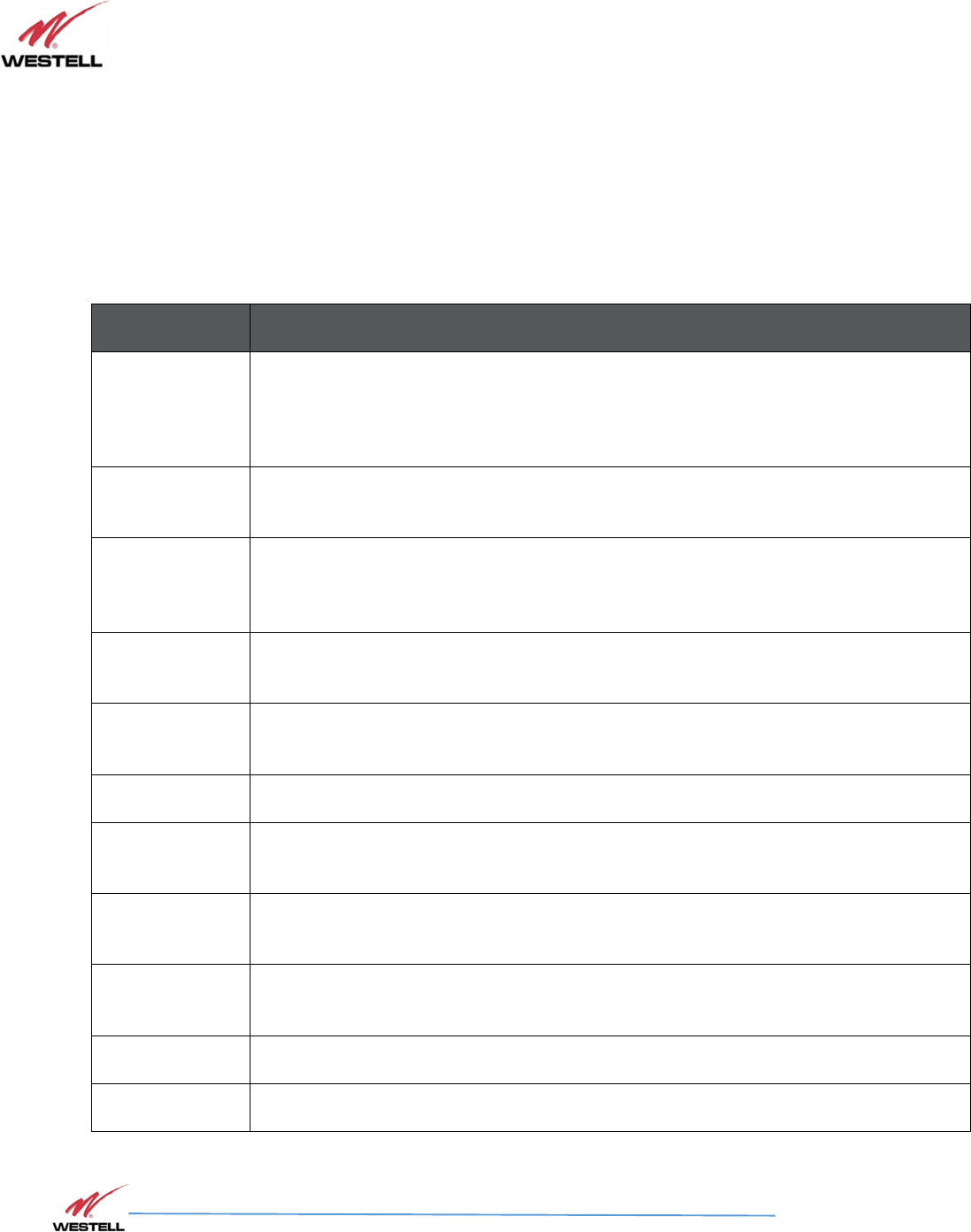
VHF Product Manual
July 2018, Rev B
WESTELL.COM
©2017 Westell Technologies July 2018; Doc No. VHF Signal Booster UM RA
1.877.844.4274 Page 9 of 95
References
References References
References
•
FCC Part 90
Document Conventions
Document Conventions Document Conventions
Document Conventions
Table P-1 lists the conventions used throughout this document.
Table P-1: Document Conventions
Convention
Description
DANGER!
Description of an imminent hazard that, if not avoided, may result in severe personal
injury or death. Before you work on equipment, be aware of the hazards involved with
electrical and RF circuitry and be familiar with standard practices for preventing
accidents.
WARNING!
Description of an imminent hazard that, if not avoided, may result in personal injury or
serious equipment damage.
CAUTION
Description of a conditions or practice that could cause damage to equipment or
property. Communicates information that is crucial to preventing loss of data or damage
to hardware or software, and actions that could result in equipment failure.
IMPORTANT
Additional important information that the user must be aware of, but is not related to a
hazard.
NOTE
Additional information that is beneficial for the user to know, but is not related to a
hazard.
Bold
Bold text indicates an action or provides emphasis.
Click
Instructs the user to press the primary (typically left) mouse button while the pointer is
over the specified location.
Right
-
click
Instructs the user to press the secondary (typically right) mouse button while the pointer
is over the specified location.
Double
-
click
Instructs the user to press the primary (typically left) mouse button twice, rapidly, while
the pointer is over the specified location.
Select
Instructs the user to perform a selection on the screen by clicking an active object.
Enter
Instructs the user to type text using the keyboard.
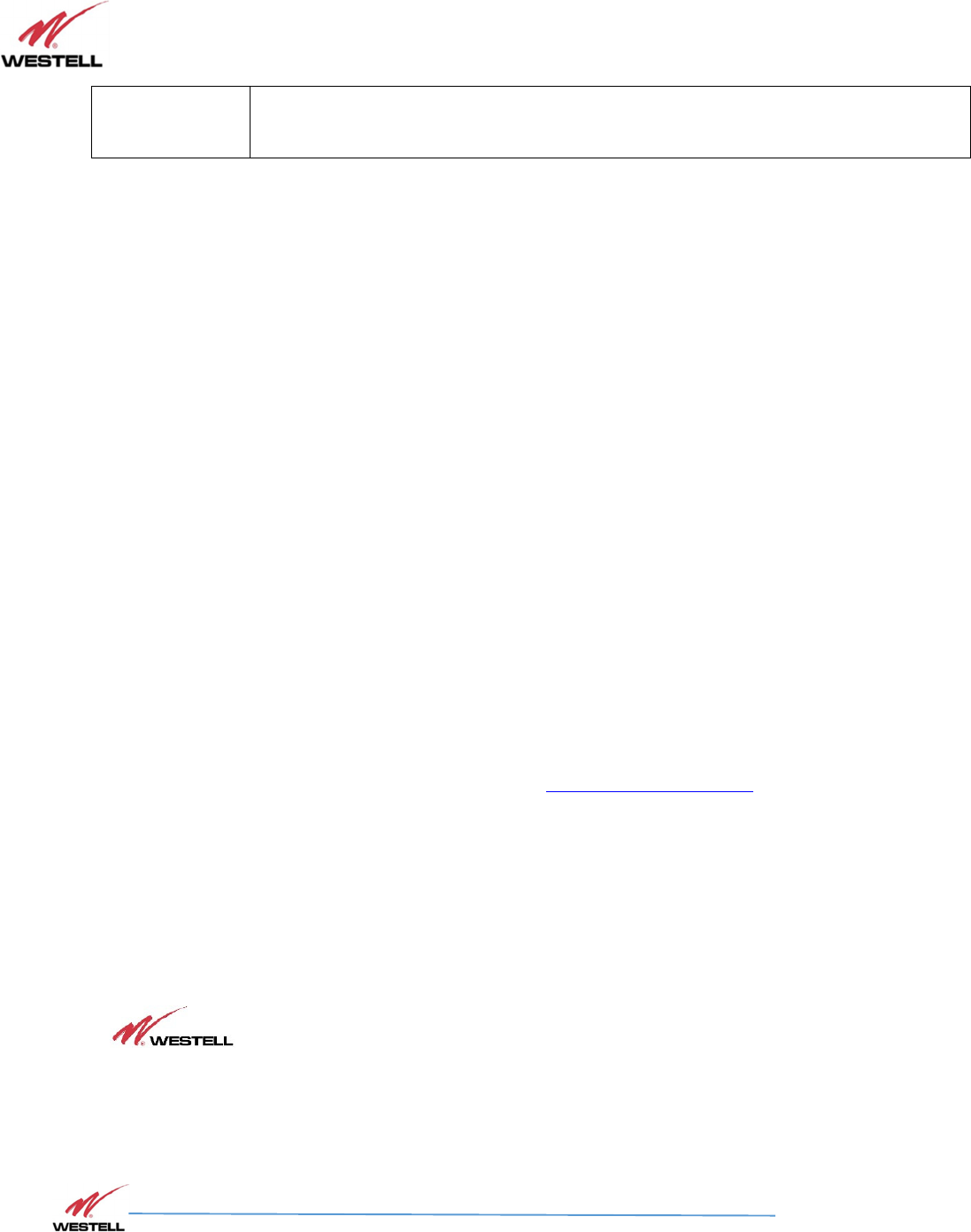
VHF Product Manual
July 2018, Rev B
WESTELL.COM
©2017 Westell Technologies July 2018; Doc No. VHF Signal Booster UM RA
1.877.844.4274 Page 10 of 95
>
Indicates a level in a menu. For example,
Start>Programs
prompts the user to click on
Start, then locate and click Programs under the Start menu.
Safety Notices
Safety Notices Safety Notices
Safety Notices
This general safety information applies to both operating and service personnel. Specific warnings and
cautions are located in other parts of this manual where they apply and may not appear in this
summary. Failure to comply with these precautions or specific warnings elsewhere in the manual
violates the safety standards of design, manufacture, and intended use of equipment.
Westell assumes no liability for the customer’s or user’s failure to comply with these requirements:
•
Explosive atmospheres - To avoid explosion or fire, do not operate this product in the
presence of flammable gases or fumes.
•
Lightning danger - Do not install or make adjustments to this unit during an electrical storm.
WARNING!
Changes and Modifications not expressly approved by Westell can void your
authority to operate this equipment under Federal Communications Commission’s
rules.
Technical Support
Technical SupportTechnical Support
Technical Support
If you suspect a malfunction with this product or have a technical question, call your dealer or the
Westell Support Line at: (603) 626-6677, Toll Free (USA) 1-877-844-4274, press option 2, and then
option 1. Westell Support can also be reached via email at IBWsupport@westell.com.
Acronyms and Abbreviations
Acronyms and Abbreviations Acronyms and Abbreviations
Acronyms and Abbreviations
Refer to Appendix B for definitions of the acronyms and abbreviations used in this manual.
Copyright and Trademark Acknowledgements
Copyright and Trademark Acknowledgements Copyright and Trademark Acknowledgements
Copyright and Trademark Acknowledgements
The following products are referred to in this manual:
• is a registered trademark of Westell Technologies, Inc.
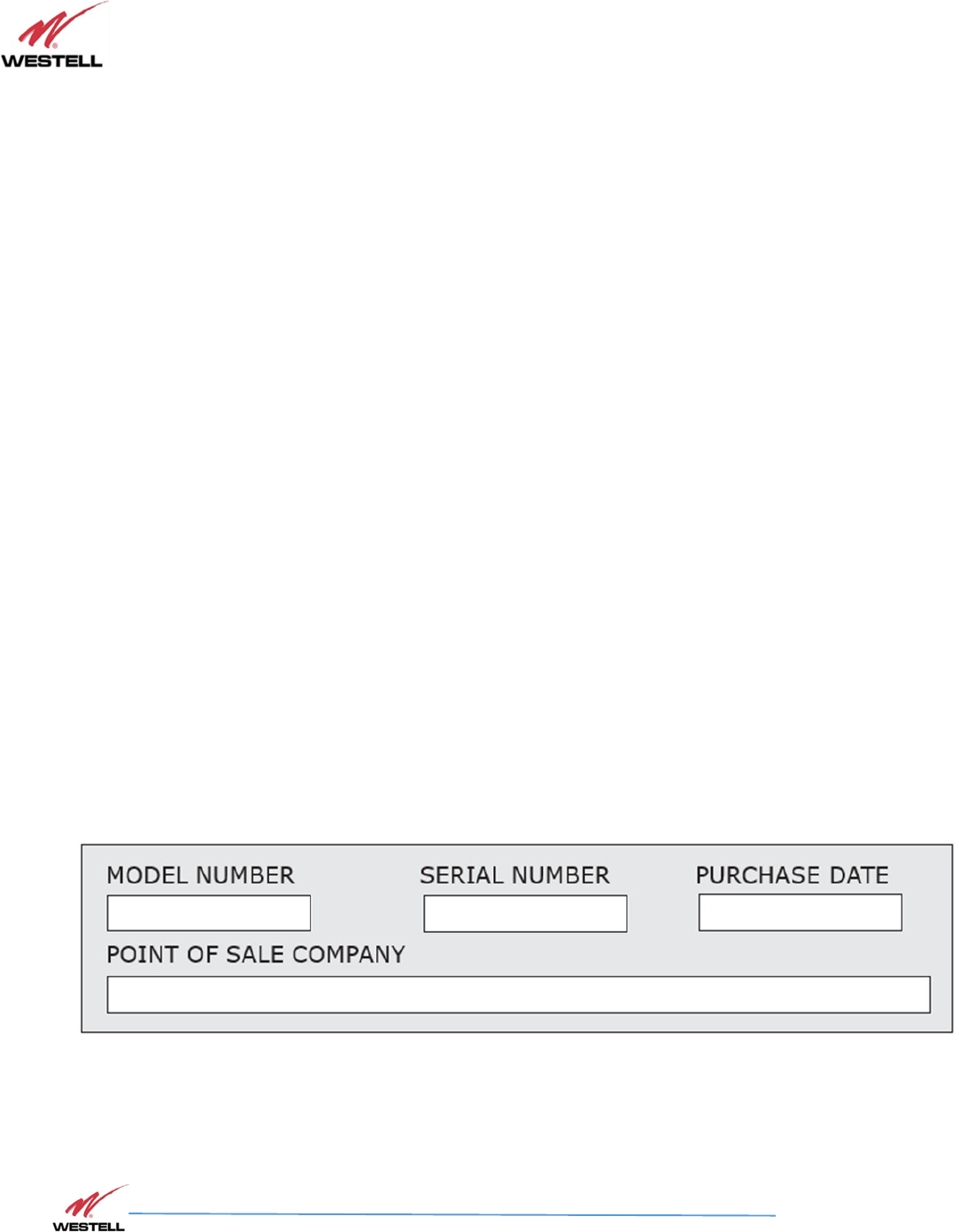
VHF Product Manual
July 2018, Rev B
WESTELL.COM
©2017 Westell Technologies July 2018; Doc No. VHF Signal Booster UM RA
1.877.844.4274 Page 11 of 95
1 General Information
1.1 Document Purpose and Intended Users
The purpose of this document is to provide a step-by-step procedure to help experienced technicians or
engineers install and commission an in-building Passive Wireless Distributed Antenna System (DAS)
using Westell’s VHF Public Safety Signal Booster. Follow the instructions in this guide to minimize risks
associated with modifying a live system and preclude service interruptions. This document assumes the
technician or engineer understands the basic principles and functionality involved with an RF Signal
Booster and in-building wireless systems. This guide has been written to address the practical concerns
of the installer.
1.2 Application
Use this guide whenever there is a need to add enhanced signal capability to an existing system or
when a Signal Booster is included in a new installation.
1.2.1 Product Registration Information
The serial number is located on the label on the panel near the power connectors. Record this
number in Figure 1-1. Retain this manual, along with proof of purchase, to serve as a permanent
record of your purchase.
Figure 1-1: Product Registration
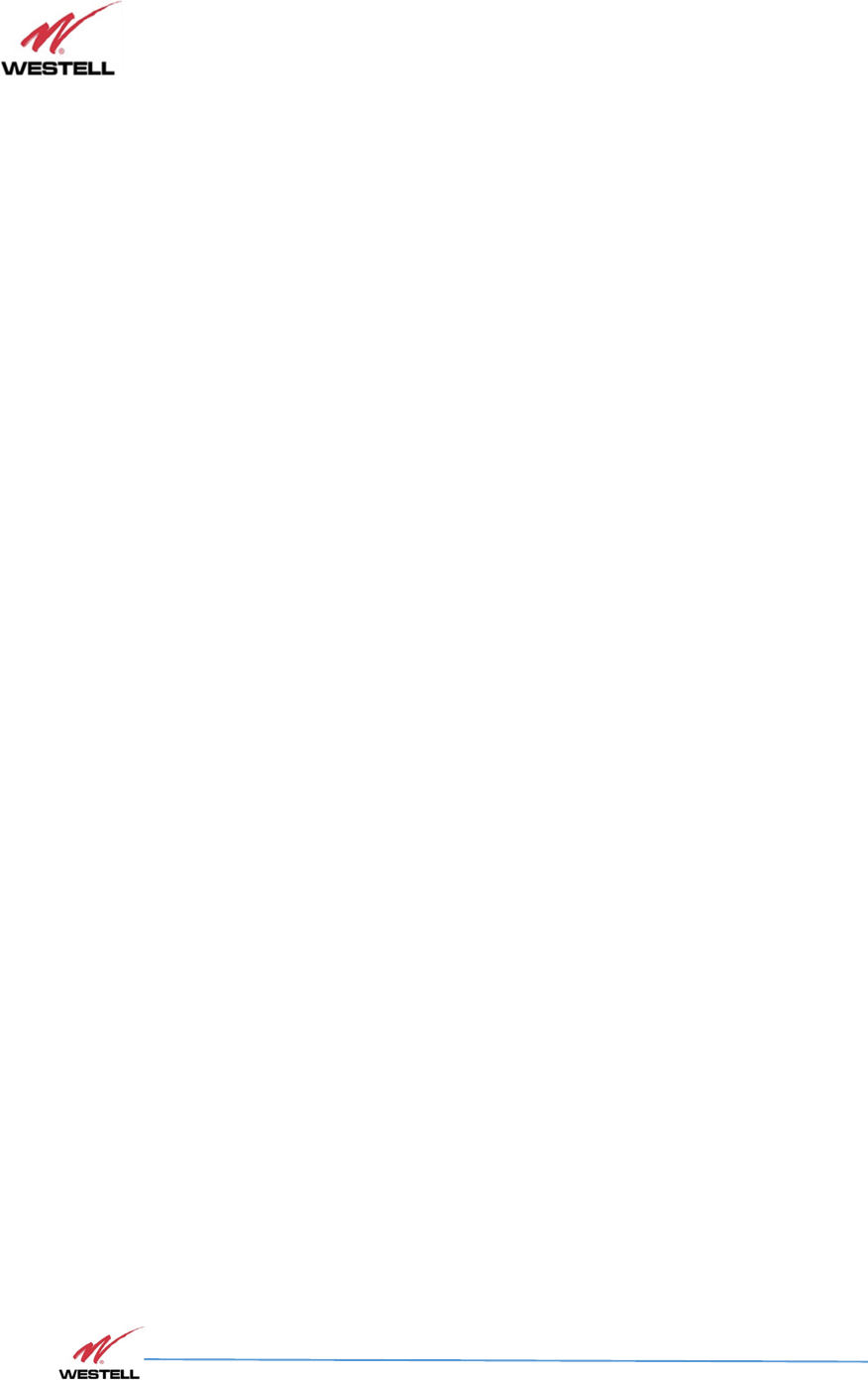
VHF Product Manual
July 2018, Rev B
WESTELL.COM
©2017 Westell Technologies July 2018; Doc No. VHF Signal Booster UM RA
1.877.844.4274 Page 12 of 95
1.3 Safety Guidelines
The general safety information in this guideline applies to both operations and service personnel.
Specific warnings and cautions are located in the applicable manual sections, but may not appear in
this summary. Failure to comply with these precautions or specific warnings elsewhere in the manual
violates safety standards of design, manufacture, and intended use of equipment. Westell assumes
no liability for the customer’s failure to comply with these requirements:
Grounding: This Signal Booster is designed to operate at 110VAC or +24/-48VDC and must always be
operated with the ground wire properly connected.
Explosive atmospheres: To avoid explosion or fire, do not operate this product in the presence of
flammable gases or fumes.
Lightning danger: Do not install or adjust this unit during an electrical storm.
No user-serviceable parts are inside the unit. Hazardous voltages are present when the cover is
removed. Opening the chassis will void your warranty. If you suspect a malfunction with this product,
call your dealer or Westell’s technical support line at 1.877.844.4274.
CAUTION
Turn the Signal Booster power off when connecting or disconnecting cables.
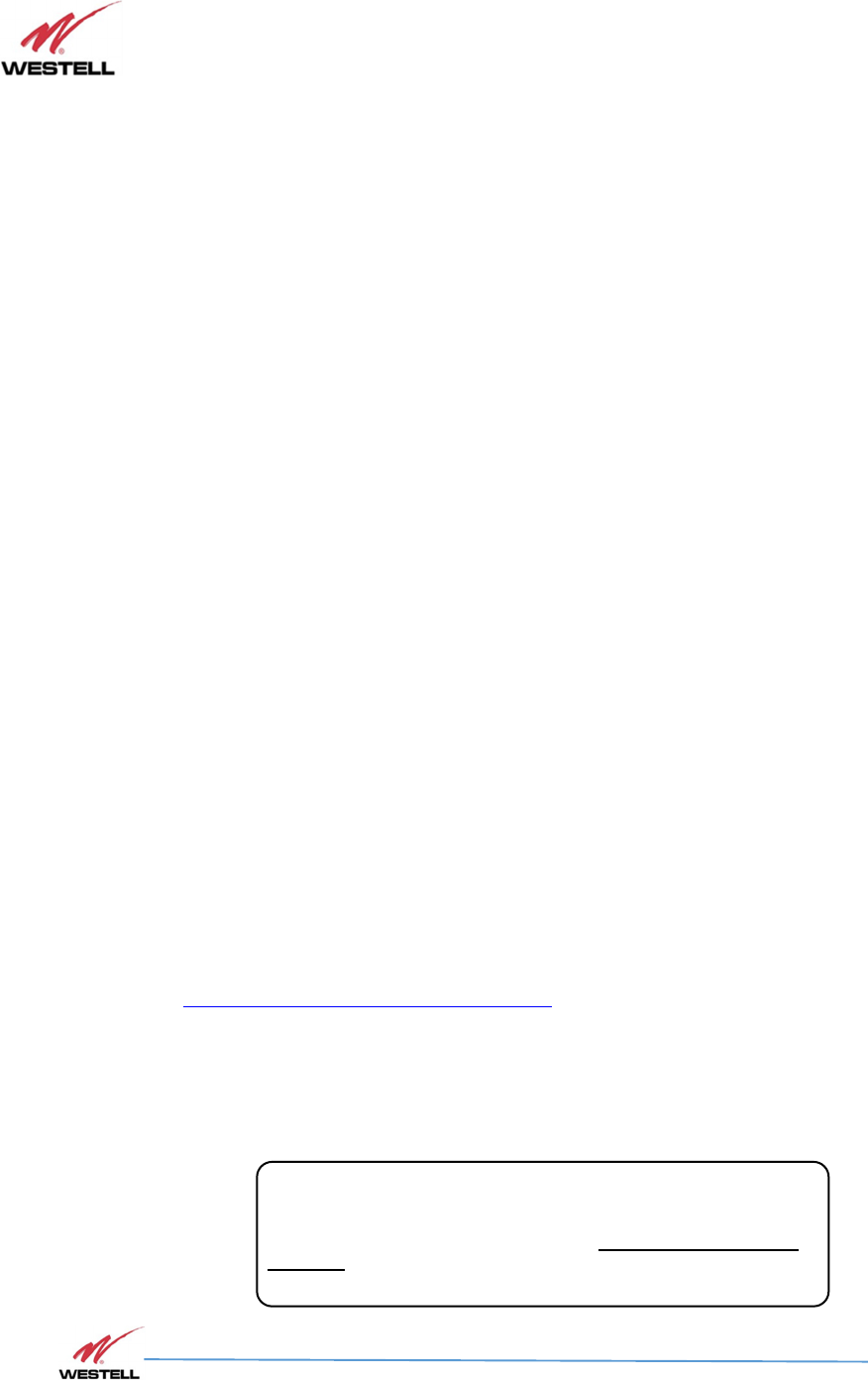
VHF Product Manual
July 2018, Rev B
WESTELL.COM
©2017 Westell Technologies July 2018; Doc No. VHF Signal Booster UM RA
1.877.844.4274 Page 13 of 95
1.3.1 Important Safety Information
Antennas used for the purpose of radiating signals indoors are limited to a maximum gain of 10 dBi.
Each antenna must be positioned to observe minimum separation requirements from all users and
bystanders.
The following guidelines must be used when considering separation distances:
•
Indoor antennas must be placed so that under normal conditions, personnel cannot come
within 55 cm of any inside antenna. Adhering to this minimum separation will ensure that
the employee or bystander cannot exceed RF exposures beyond the maximum permissible
limit as defined by FCC Regulations section 1.1310 Limits for general
population/uncontrolled exposure.
•
Outdoor antenna must be positioned so that under normal conditions, personnel cannot
approach closer than 55 cm. A directional antenna having a maximum gain of 10 dBi is used,
and precautions should be taken to prevent personnel from routinely passing through the
main radiation beam at a distance closer than specified.
1.4 FCC Part 90 Signal Boosters
WARNING!
THIS IS A 90.219 CLASS B DEVICE
This is not a consumer device. It is designed for installation by FCC licensees and qualified
installers. You must have an FCC license or express consent of an FCC Licensee to operate
this device. You must register class B signal boosters (as defined in 47 CFR 90.219) online
at www.fcc.gov/signal-boosters/registration. Unauthorized use may result in significant
forfeiture penalties, including penalties in excess of $100,000 for each continuing
violation.
FCC Warning Label
The following label will appear on the VHF Signal Booster in accordance with the FCC:
WARNING This is NOT a CONSUMER device. It is designed for in stallatio n by FCC
LICENSEES and QUALIFIED INSTALLERS. You MUST have an FCC LICENSE or express
consent of an FCC Licensee to operate this d evice. You MUST register Class B signal
boosters (as defined in 47 CFR 90.219) online at www.fcc.gov/signal-boosters/
registration. Unauthorized use may result in significant forfeiture penalties, including
penalties in excess of $100,000 for each continuing violation.
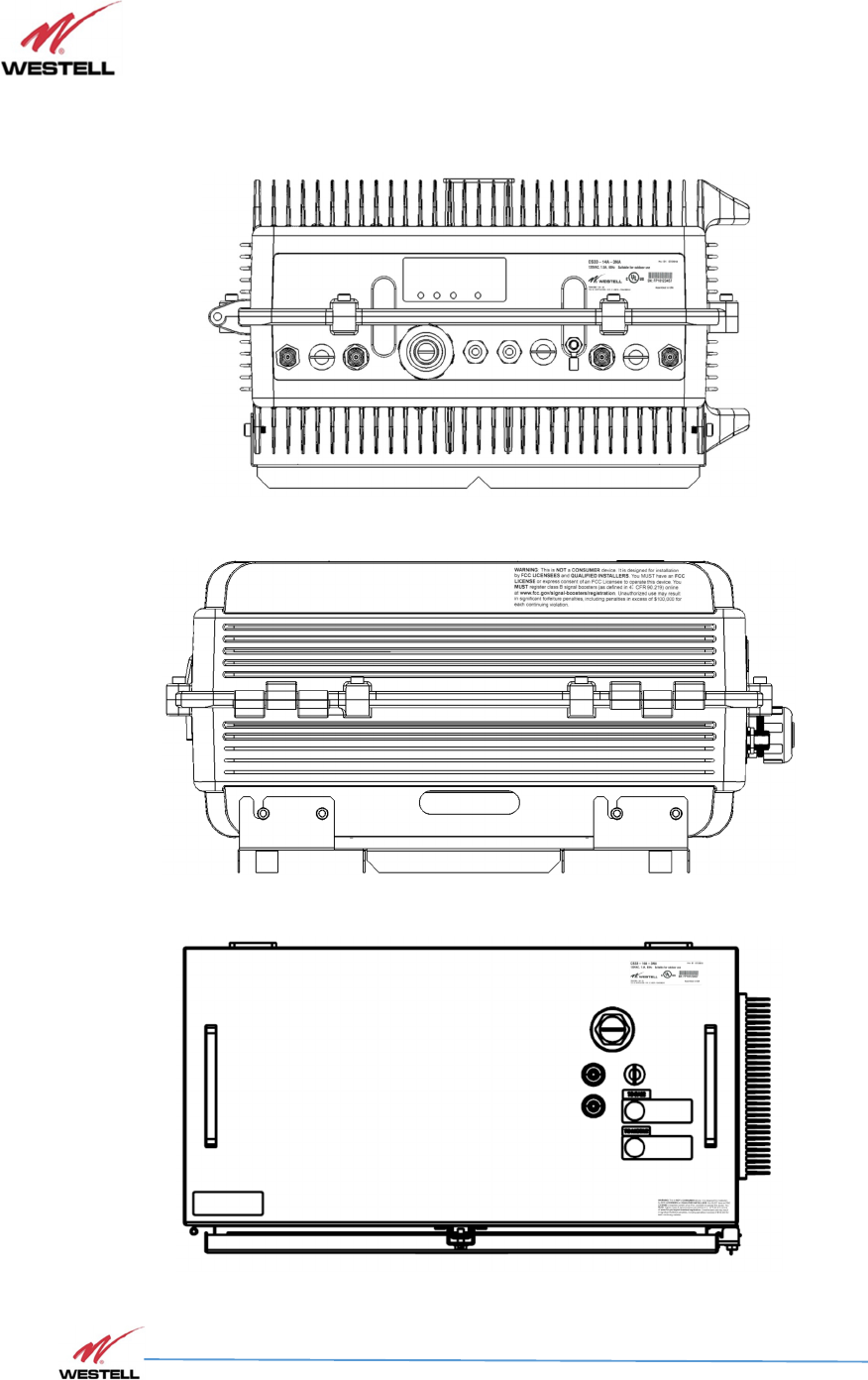
VHF Product Manual
July 2018, Rev B
WESTELL.COM
©2017 Westell Technologies July 2018; Doc No. VHF Signal Booster UM RA
1.877.844.4274 Page 14 of 95
FCC Label Placement on the VHF Signal Booster:
Top View
Side View
Top View
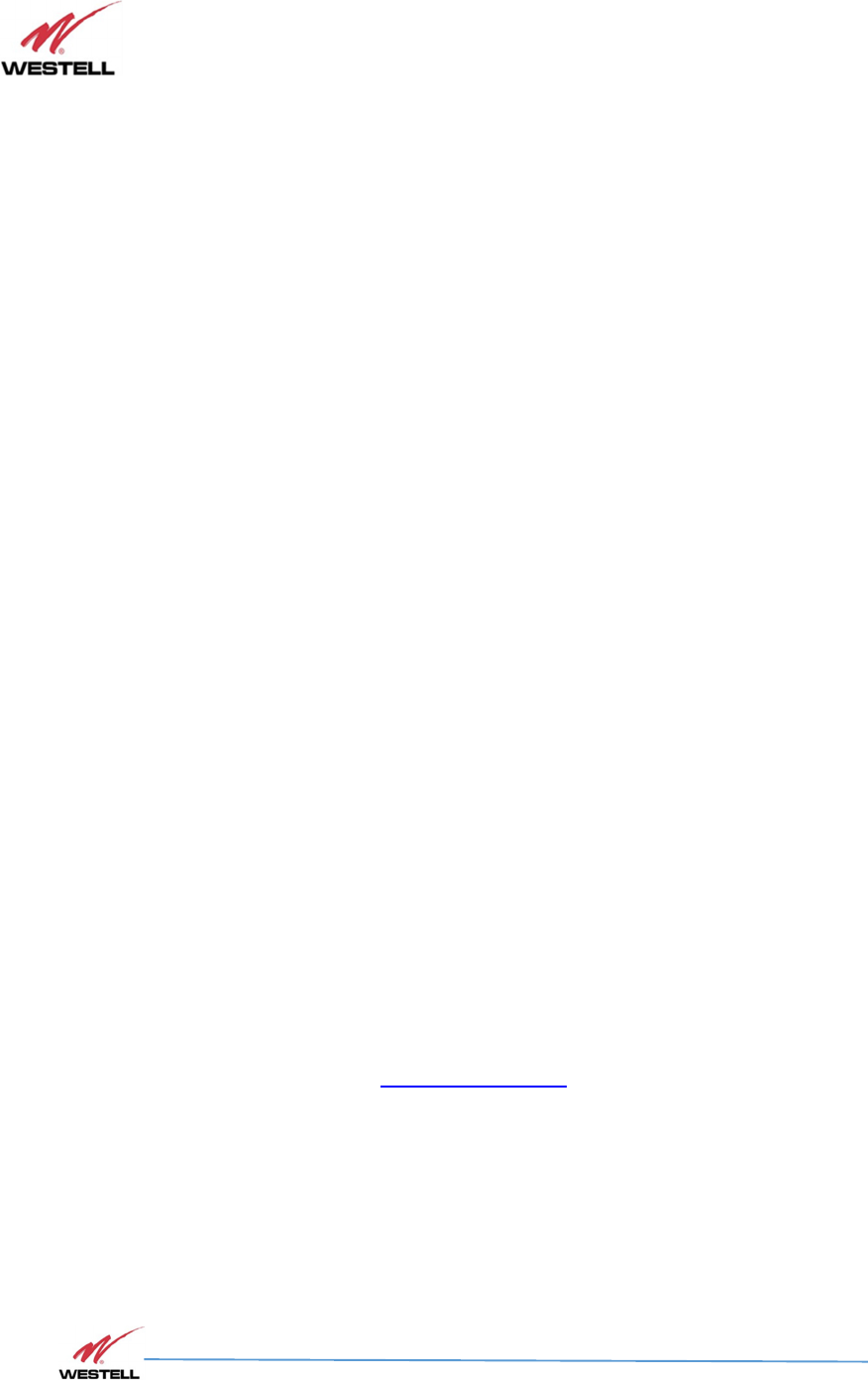
VHF Product Manual
July 2018, Rev B
WESTELL.COM
©2017 Westell Technologies July 2018; Doc No. VHF Signal Booster UM RA
1.877.844.4274 Page 15 of 95
1.5 FCC Contact Information:
Federal Communications Commission
445 12th Street SW
Washington, DC 20554
Phone: 1-888-225-5322
TTY: 1-888-835-5322
Fax: 1-866-418-0232
IC Compliance
As per RSS-131 Issue 3:
• Nominal passband gain: 80dB
• Nominal bandwidth: 2MHz
• Rated mean output power: +24dBm
• Input and Output impedances: 50 ohms
The Manufacturer’s rated output power of this equipment is for single carrier operation. For situations
when multiple carrier signals are present the rating would have to be reduced by 3.5dB especially
where the signal is re-radiated and can cause interference to adjacent band users. This power
reduction is to be by means of input power or gain reduction and not by an attenuator at the output
of the device.
RF exposure statement for ISED: “This device complies with Health Canada’s Safety Code. The installer
of this radio equipment must ensure that the antenna is located or pointed such that it does not emit
RF filed in excess of Health Canada limits for the general population; consult safety code 6, obtainable
from Health Canada’s website at www.hc-sc.gc.ca/rpb”
The antenna/s used for this transmitter must be installed to provide a separation of at least 55 cm in
DL and 55 cm in UL from all persons and must not be collocated or operating in conjunction with any
other antenna or transmitter. Changes or modifications not expressly approved by the party
responsible for compliance could void the user’s authority to operate the equipment.
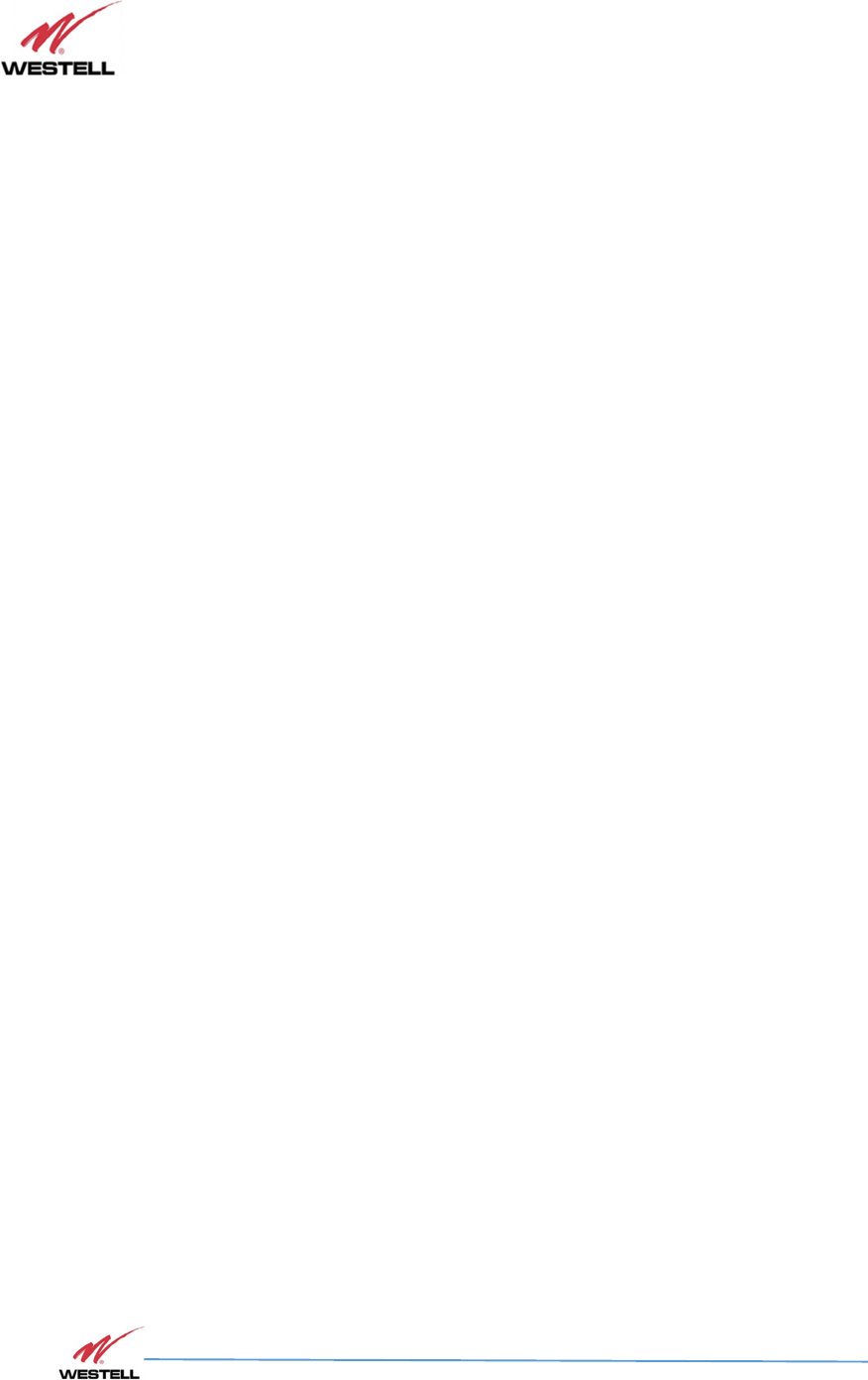
VHF Product Manual
July 2018, Rev B
WESTELL.COM
©2017 Westell Technologies July 2018; Doc No. VHF Signal Booster UM RA
1.877.844.4274 Page 16 of 95
Selon RSS-131 Issue 3 :
• Gain de bande passante nominale : 80dB
• Band passante nominale: 2MHz
• Puissance nominale de sortie moyenne: +24dBm
• Entrée et sortie impédances: 50 ohms
Puissance de sortie nominale du fabricant de cet équipement est pour opération porteuse unique.
Pour les situations lorsque plusieurs signaux porteurs figurent la notation devra être réduite de 3.5dB
surtout où le signal est re-rayonné et peut causer des interférences aux utilisateurs de la bande
adjacente. Cette réduction de puissance doit être au moyen de la réduction de puissance ou de gain
d’entrée et non par un atténuateur à la sortie de l’appareil.
Déclaration d’exposition aux RF pour ISED : « Cet appareil est conforme avec le Code de sécurité de
Santé Canada. Le programme d’installation de cet équipement radio doit s’assurer que l’antenne est
située ou fait telle qu’elle n’émet pas de RF a déposé plus de limites de Santé Canada pour la
population générale ; consulter le code de sécurité 6, disponible depuis le site Web de Santé Canada à
www.hc-sc.gc.ca/rpb »
L’antenne/s utilisée pour ce transmetteur doit être installé pour fournir une séparation d’au moins 55
cm en DL et UL 55 cm de toute personne et ne doit pas être colocalisés ou fonctionner en conjonction
avec toute autre antenne ou transmetteur. Changements ou modifications non expressément
approuvées par la partie responsable de la conformité pourraient annuler autorisation votre d’utiliser
l’équipement.
2 Product Overview
2.1 Product Information
The VHF Signal Booster was developed for use in enclosed structures where signals from local public
safety towers to operate mobile units is poor or unavailable. Adequate signal strength must be
available outside the structure as a prerequisite to achieving in-building coverage. The device is
connected to an external antenna, normally located on a roof, and to one or more internal antennas
placed strategically throughout the area where wireless service is desired.
The VHF Signal Booster Series is a Digital Signal Booster that operates in the 136 – 174 MHz frequency
range.
The external antenna is typically directional, such as a Yagi or Panel antenna. Internal antennas are
typically omnidirectional, although various other types may be used, depending on the coverage
application. The Signal Booster amplifies both the uplink (mobile to base) and downlink (base to
mobile) signals, thus facilitating communications to and from the intended wireless infrastructure.
With a maximum total of 80 dB nominal gain on both the uplink and downlink, gain can be adjusted
over a range from 52 dB to 80 dB in 1 dB steps.
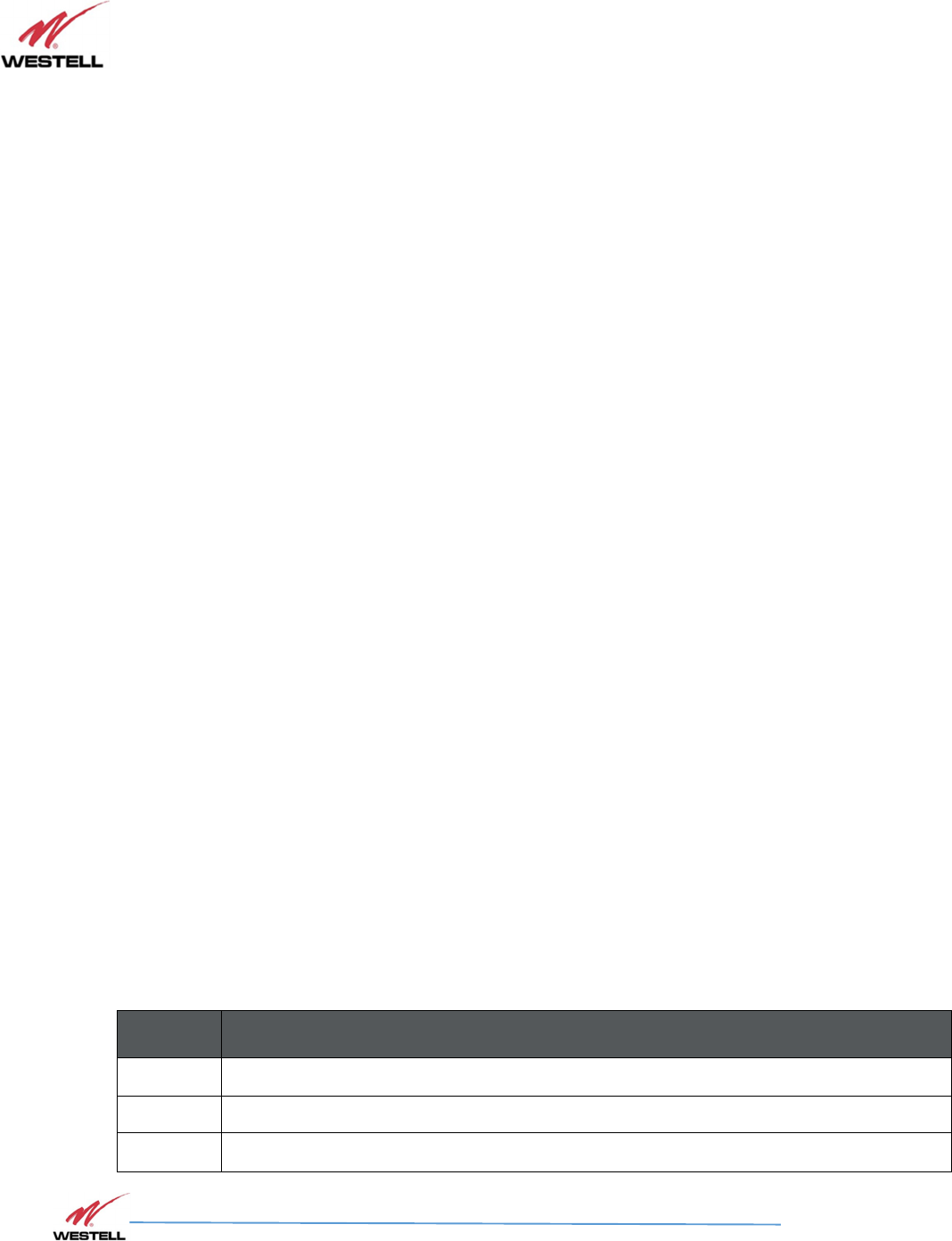
VHF Product Manual
July 2018, Rev B
WESTELL.COM
©2017 Westell Technologies July 2018; Doc No. VHF Signal Booster UM RA
1.877.844.4274 Page 17 of 95
Each band has a separate intermediate filtering. The intermediate filtering is done using FPGA based
Digital Signal Processing that, among many, has the following features:
• High Selectivity vs Low Delay
• AGC per channel and per time slot
• Squelch per channel and per time slot
• Integrated Spectrum Analyzer
This Signal Booster is capable of handling 32 filters in uplink and 32 filters in downlink. The center
frequency and BW of each one of the filters can be tuned via a software interface.
This Digital Signal Booster is intended to be used in P25Ph1, P25Ph2, TETRA, DMR, Mototrb and
Conventional radio systems.
This Digital Signal Booster has a heavy duty IP67/NEMA4X cabinet for outdoor usage, it is designed to
be wall or pole mounted.
2.2 Product Features
• Digital Class A
• Channel Selective
• 24 dBm (1/4 Watt)
• Supports up to 32 Channels (Uplink and Downlink)
• NFPA 1221 & 72 (2016) compliant
• IP67/NEMA 4X enclosure
• Uplink and Downlink squelch, per channel
• UL Listed
• Independent power and gain control per channel
• 80 dB Gain
• Integrated spectrum analyzer
• Dry Contacts for fire panel connection
• Supports SNMP
• Web-Based GUI
2.3 Included Accessories
Table 2-1 contains the items that are shipped with the UHF Public Safety Signal Booster.
Table 2-1: Included Accessories
Quantity
Description
1
AC or DC Power Cord
1
Hex Key
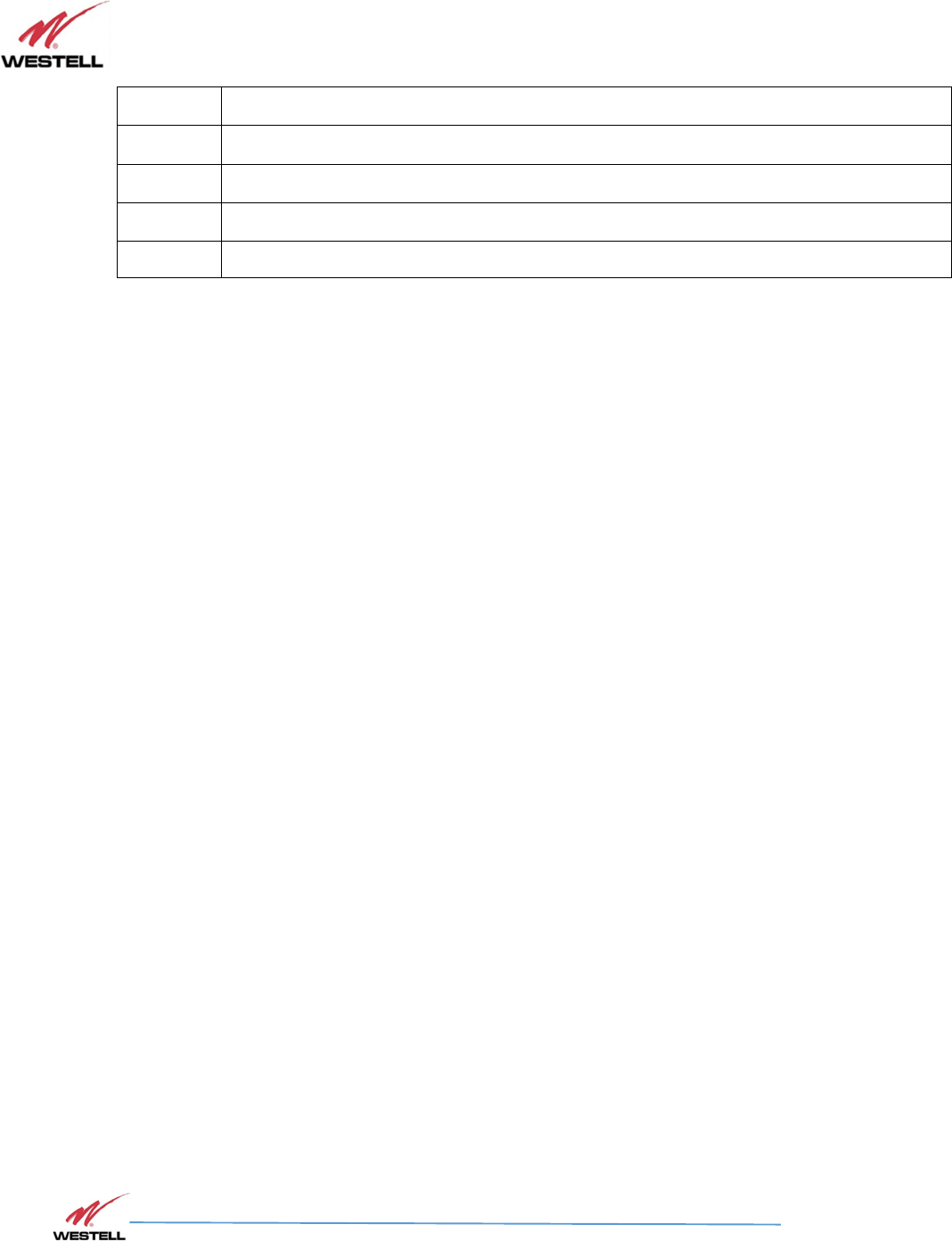
VHF Product Manual
July 2018, Rev B
WESTELL.COM
©2017 Westell Technologies July 2018; Doc No. VHF Signal Booster UM RA
1.877.844.4274 Page 18 of 95
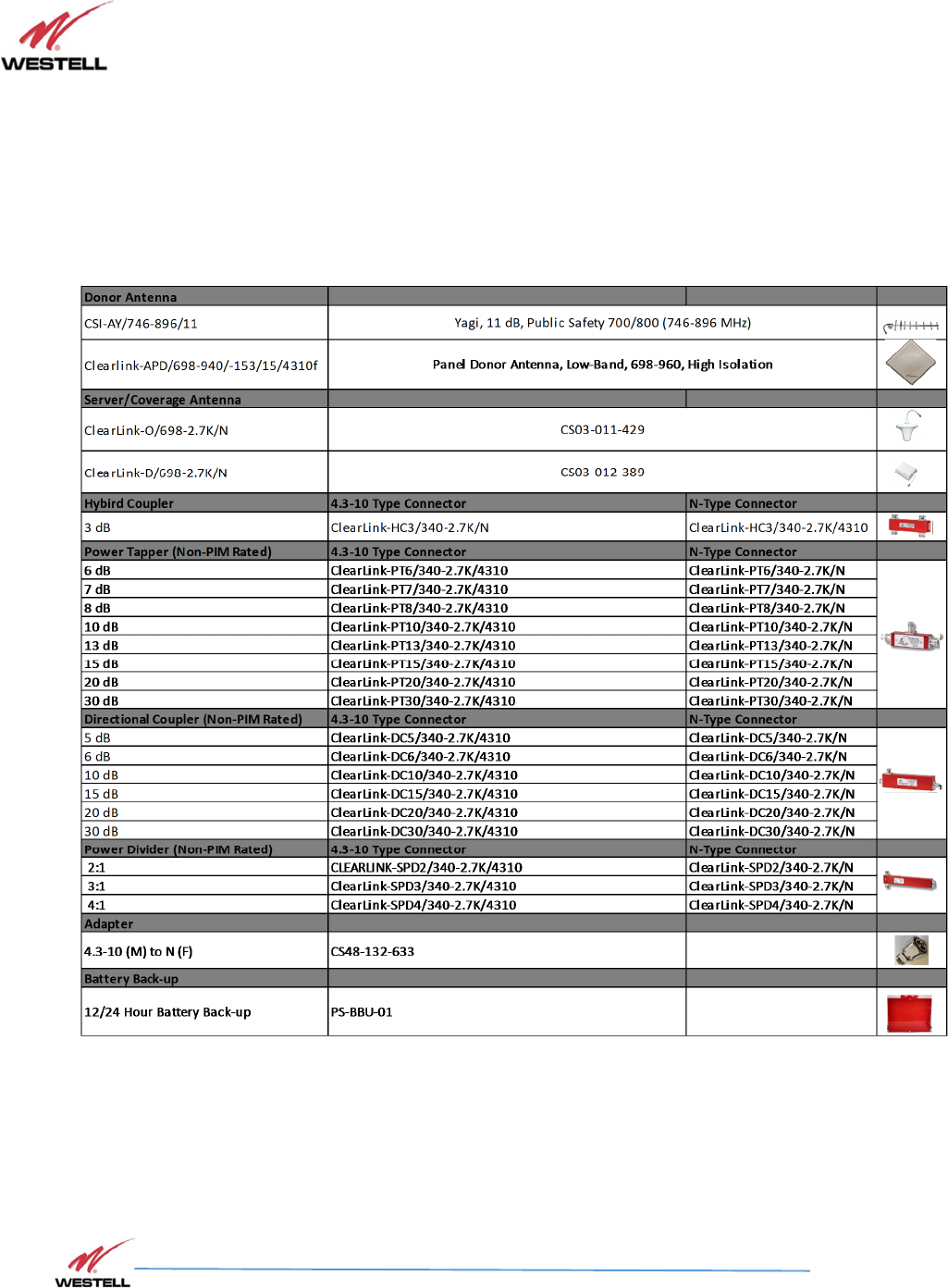
VHF Product Manual
July 2018, Rev B
WESTELL.COM
©2017 Westell Technologies July 2018; Doc No. VHF Signal Booster UM RA
1.877.844.4274 Page 19 of 95
2.4 Optional Accessories
A complete line of accessories is available from Westell. Check with your Westell distributor for any
additional items needed. Some products that are suitable for most in-building needs are listed in
Table 2-2.
Table 2-2: Optional Accessories
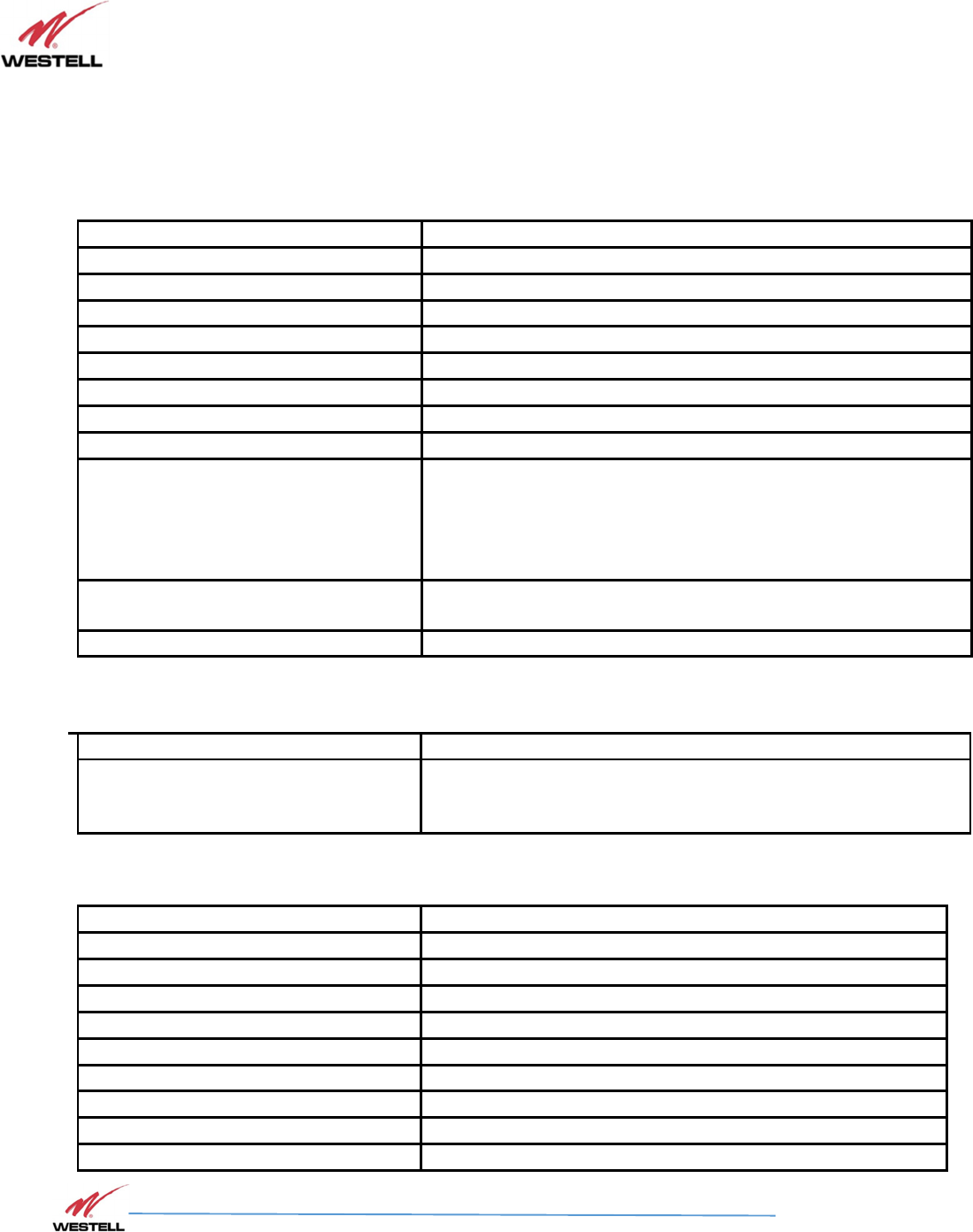
VHF Product Manual
July 2018, Rev B
WESTELL.COM
©2017 Westell Technologies July 2018; Doc No. VHF Signal Booster UM RA
1.877.844.4274 Page 20 of 95
3 Product Specifications
3.1 RF Specifications
Frequency Range
136
-
174
MHz
Downlink Output Power
24 dBm (1/4 Watt)
Uplink Power
24 dBm (1/4 Watt)
Channels Supported
Up to 32 Uplink and Downlink
Gain
80 dBm
Attenuation Range
52
-
80 dB, 1 dB increments
Passband
Channel Selective (90 KHz, 45 KHz, 30 KHz, 20 KHz, and 15 KHz BW)
IMD
<
-
13 dBm
Noise Figure
9
.0 dB Max
Delay
90 KHz, 14μs
45 KHz, 23μs
30 KHz, 32μs
20 KHz, 45μs
15 KHz, 55μs
Input Power (w/o Damage)
0 dBm Uplink (Max)
-20 dBm Downlink (Max)
VSWR
1.5:1 Max
3.2 Electrical Specifications
Specification
Main Power Input Voltage
110
/220
VAC or
DC (+24VDC to
-
48VDC)
Power Consumption
1/4W Power Output
<170W Max.
3.3 Mechanical Specifications
Dimensions (LxWxD)
20.2 x 18.2 x 9 inches (WST0
12
)
Weight
55 lbs.
(WST012)
Cooling
Passive
Weatherproofing
IP
-
67/NEMA 4X
Connectors
Antenna Ports
N
-
Type Female
User Interface
USB
Alarm Relay
6
-
Wire Dry Contact Connector
Operating Temperature
-
2
5 ° t
o +
55 ° C
Mounting
Wall, Rack or Pole mounting
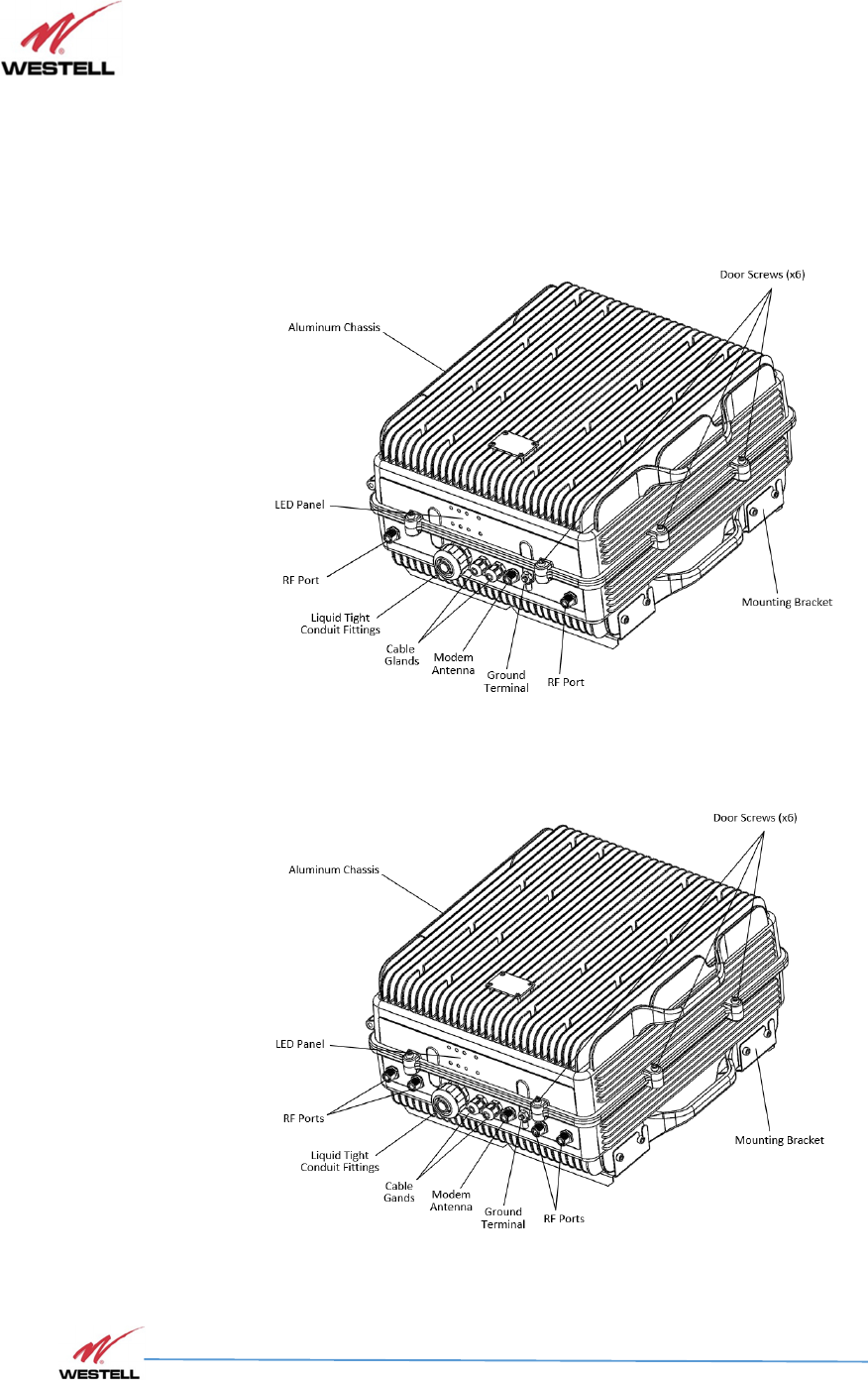
VHF Product Manual
July 2018, Rev B
WESTELL.COM
©2017 Westell Technologies July 2018; Doc No. VHF Signal Booster UM RA
1.877.844.4274 Page 21 of 95
4 Product Appearance
4 Product Appearance4 Product Appearance
4 Product Appearance
4.1 External Configuration
Figure:
Figure: Figure:
Figure:
VHF
“
2 Port
”
Duplexed Configuration
Figure:
Figure: Figure:
Figure:
VHF
“
4 Port
”
Non-Duplexed Configuration
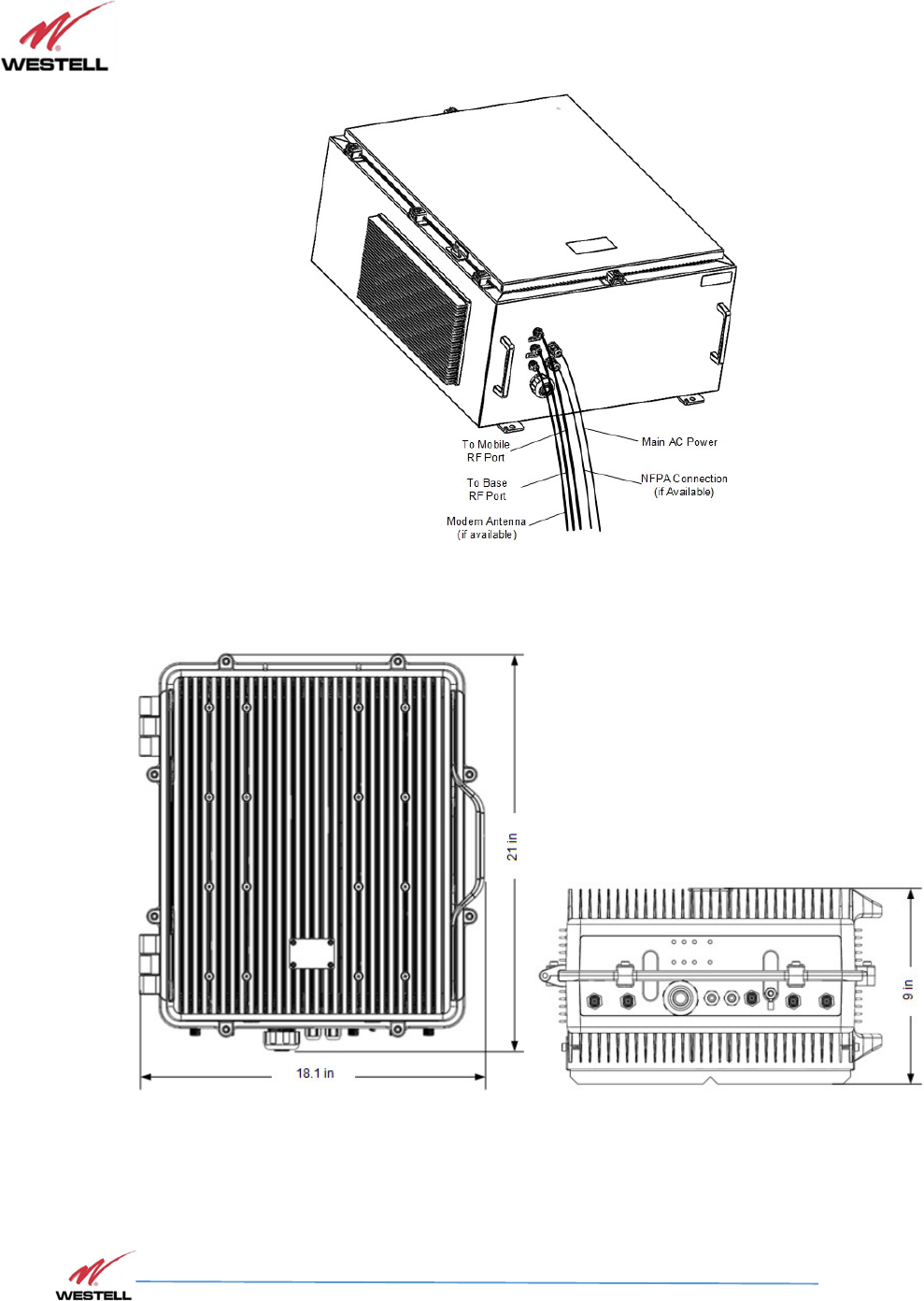
VHF Product Manual
July 2018, Rev B
WESTELL.COM
©2017 Westell Technologies July 2018; Doc No. VHF Signal Booster UM RA
1.877.844.4274 Page 22 of 95
Figure:
Figure: Figure:
Figure:
WST021 Configuration
5
5 5
5 Product Dimensions
Product DimensionsProduct Dimensions
Product Dimensions
Figure: WST012 dimensions
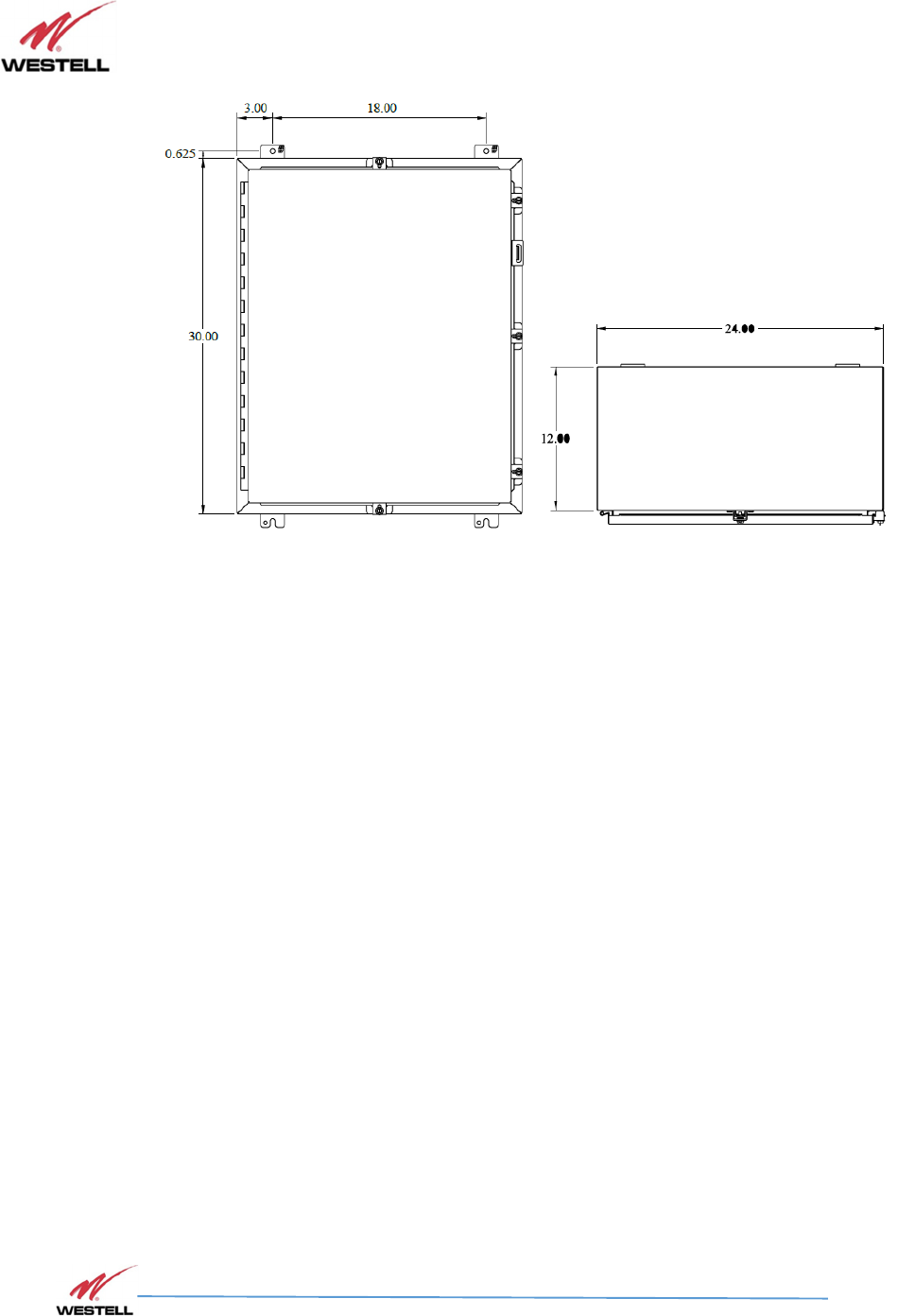
VHF Product Manual
July 2018, Rev B
WESTELL.COM
©2017 Westell Technologies July 2018; Doc No. VHF Signal Booster UM RA
1.877.844.4274 Page 23 of 95
Figure:
Figure: Figure:
Figure:
WST021 dimensions
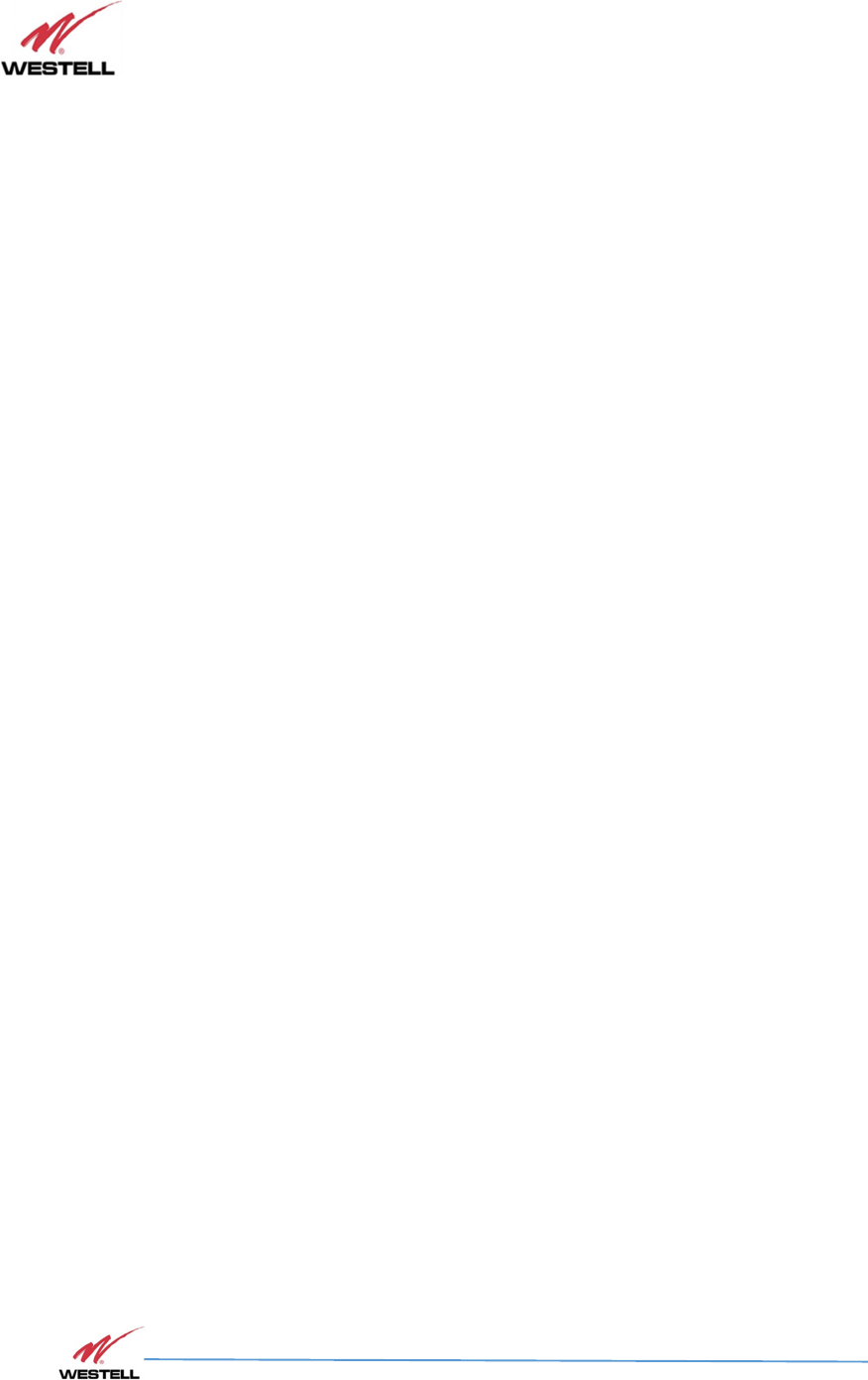
VHF Product Manual
July 2018, Rev B
WESTELL.COM
©2017 Westell Technologies July 2018; Doc No. VHF Signal Booster UM RA
1.877.844.4274 Page 24 of 95
5 Installation Guidelines
5.1 Important Installation Guidelines
• Westell Signal Boosters are designed for outdoor usage with a weather proof outdoor NEMA4 cabinet
that can be mounted without any kind of shelter from rain, snow or hail.
• The Signal Booster must be installed in a vertical orientation (i.e. Connectors on the bottom of the
unit).
• Inadequate isolation between the outside and inside antennas may cause regenerative feedback in
the system.
• This feedback can cause the amplifier to emit a continuous signal at maximum
Amplitude, and, in some cases, interfere with normal operation of the donor site.
Careful consideration of the layout and placement of the system is imperative to minimize this
possibility and to minimize the amount of signal leaking from the
Building.
• Do not disassemble the Signal Booster.
Danger!
• Refer to the 1.3 Safety Guidelines section for proper antenna selection and installation. To avoid
serious injury, death and/or damage to the Signal Booster, do not install donor or server antennas near
overhead power lines or high power components. Allow enough distance so that falling antennas
would not come in contact with those components.
• Electric shock may occur if the Signal Booster is installed in close proximity to water.
WARNING!
• Amplifier or handset damage may occur if a handset is connected directly to the Signal Booster or to
the coax that leads to the Signal Booster.
• The Signal Booster must be connected to ground for protection.
• We recommend that installers do not wear jewelry or metal accessories when installing this Signal
Booster.
• Do not place cables or tools that may damage the Signal Booster in close proximity to it.
• Check the installation site for hazardous conditions such as water-covered floors or badly worn or
damaged cables prior to installation.
• Lifespan and performance of the Signal Booster may be reduced if the unit is operating outside its
nominal temperature range.
• However, to improve reliability, it is recommended to mount the Signal Booster on a site with shelter
from direct exposure to sun, rain, snow and hailing.
• It is not recommended to install the Signal Booster under bad weather conditions, such as:
• Intense rainfall, snowfall or hail
• Storm or high wind
• Extremely low or high temperature
• High humidity of the air
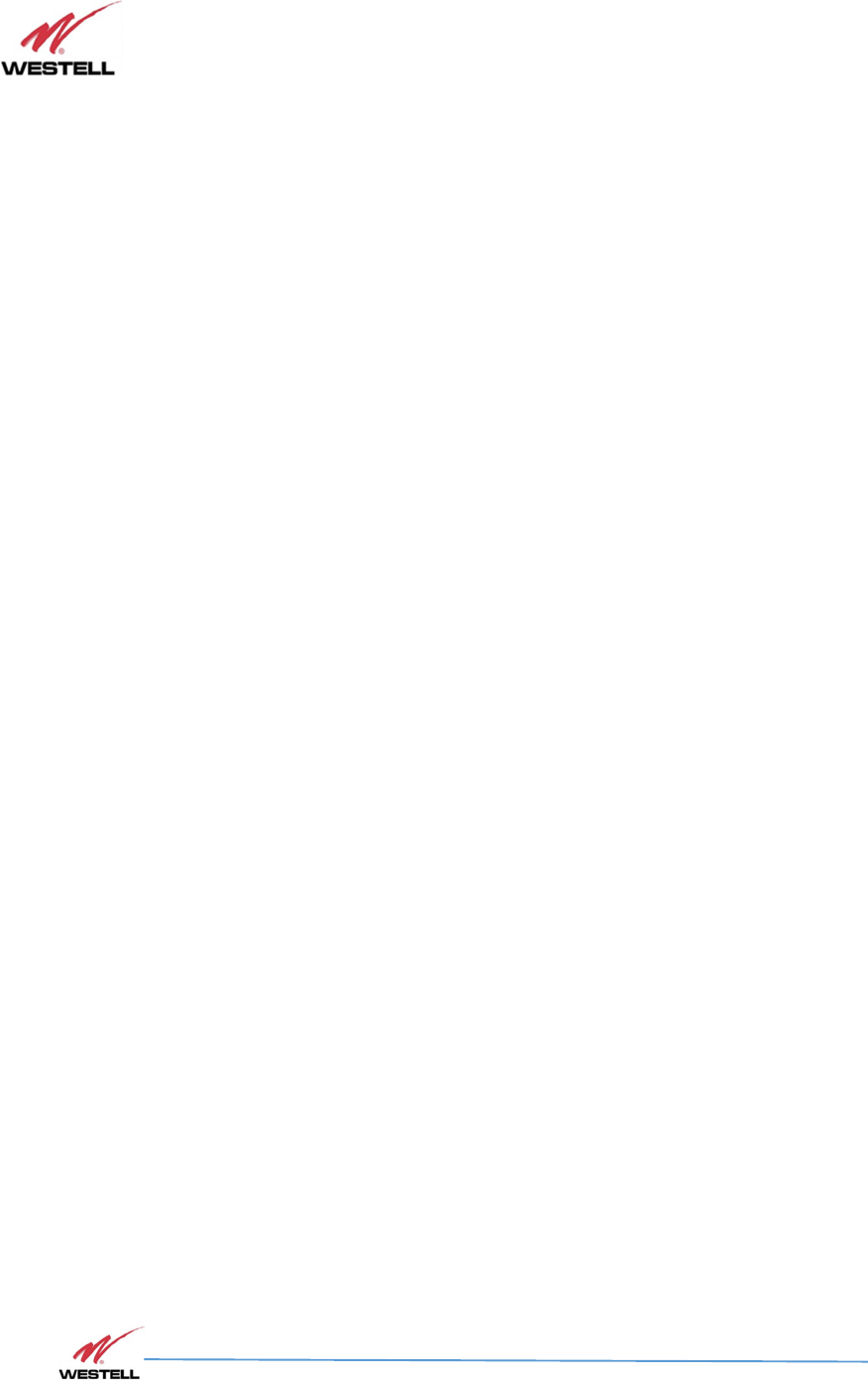
VHF Product Manual
July 2018, Rev B
WESTELL.COM
©2017 Westell Technologies July 2018; Doc No. VHF Signal Booster UM RA
1.877.844.4274 Page 25 of 95
5.2 Donor Antenna Installation Guidelines
• Accurately determine the azimuth to the donor site. Obtain the donor site information and approval from the
service provider/carrier.
• Ensure that the radiation path to the donor site is unobstructed.
• Mount the donor antenna at or toward the edge of the roof, in the direction of the donor site. Avoid having the
RF signal from the donor pass above the location(s) of the service antennas. Normally, the service antennas are
installed behind and below the donor antenna, as viewed from above. This approach helps avoid interference
and feedback to and from the service antennas.
• Normally, mounting the donor antenna higher will allow a less obstructed path to the donor site. However, in
high traffic metro areas, avoid mounting the donor antenna higher than necessary, as the quality of the donor
signal may become less stable and it is more likely to encounter adjacent channel interference.
• When possible, shield the rear of a donor antenna by locating it so that any HVAC units and/or penthouse
structures are behind the antenna, relative to the donor cell site location.
5.3 Indoor Antenna Installation Guidelines
• Use omnidirectional antennas (see section 2.4. Optional Accessories) indoors and locate them centrally with
respect to the intended coverage area to minimize signal leakage to the outside. Only use directional antennas
indoors in special cases when higher gain and directionality would be helpful and RF exposure limits will not be
exceeded.
• To avoid Signal Booster uplink overload and gain limiting, mount the indoor antennas away from areas where
mobile subscribers frequently use their phones / radios, such as desks or dispatch areas.
• To determine the quantity and locations of indoor antennas, measure Received Signal Strength Indication (RSSI)
using DM Tool software to determine areas of weak signals. These are the approximate areas where indoor
antennas may be needed.
• Be aware that the signal from an indoor antenna, in most cases, can be expected to penetrate approximately
two standard sheet rock walls to reach users. If the signal must travel through more than two walls, or if the
walls are made of materials other than sheet rock, it may be necessary to split the available signal and add more
antennas.
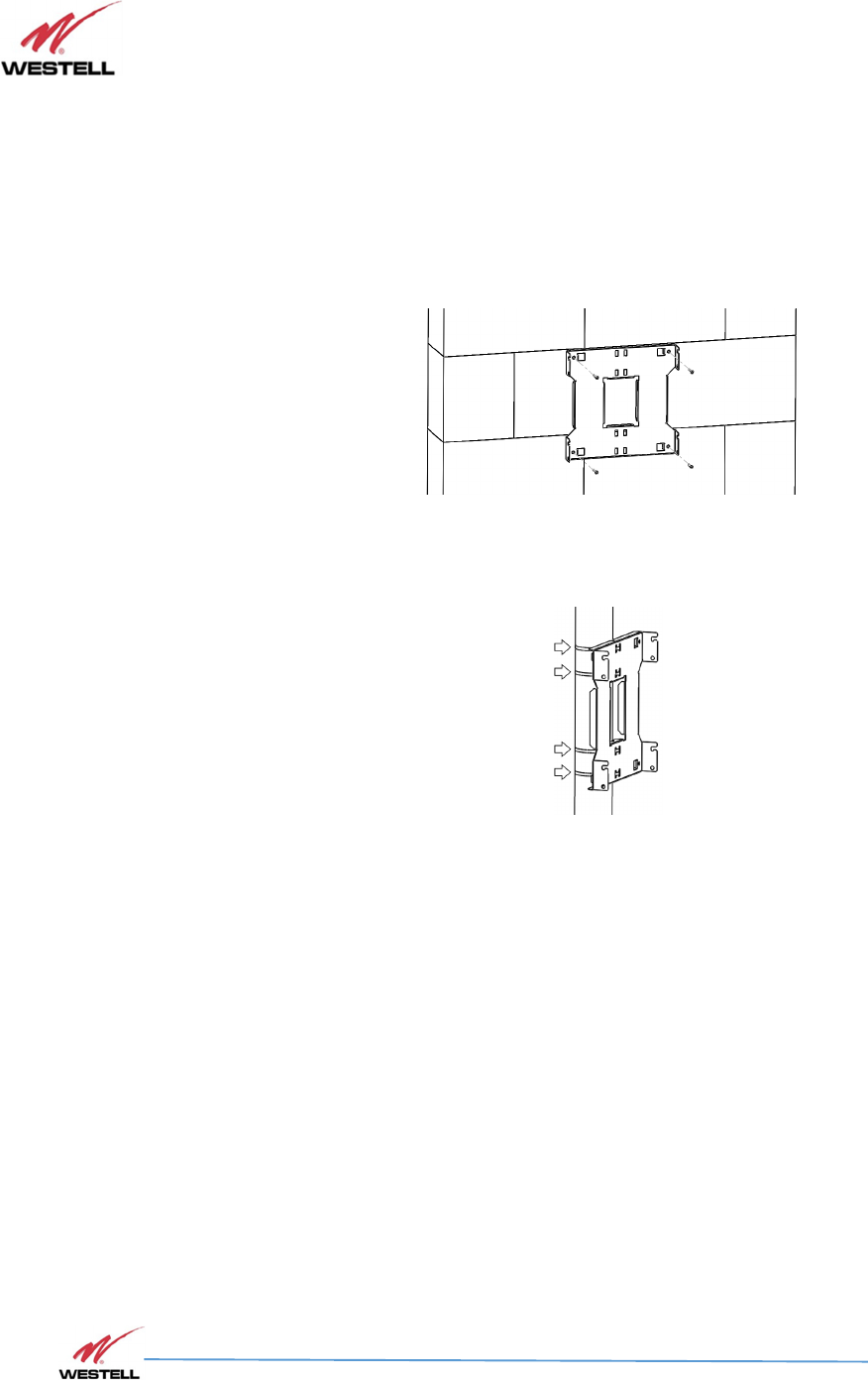
VHF Product Manual
July 2018, Rev B
WESTELL.COM
©2017 Westell Technologies July 2018; Doc No. VHF Signal Booster UM RA
1.877.844.4274 Page 26 of 95
5.4 Mounting the Signal Booster
A. Mount the bracket
The Signal Booster can be mounted on a wall or pole. The bracket is provided with the
Signal Booster.
Figure:
Figure: Figure:
Figure:
Bracket attachment to a wall using three fixing screws
Figure:
Figure: Figure:
Figure:
Bracket attachment to a pipe using four inox hose clamps
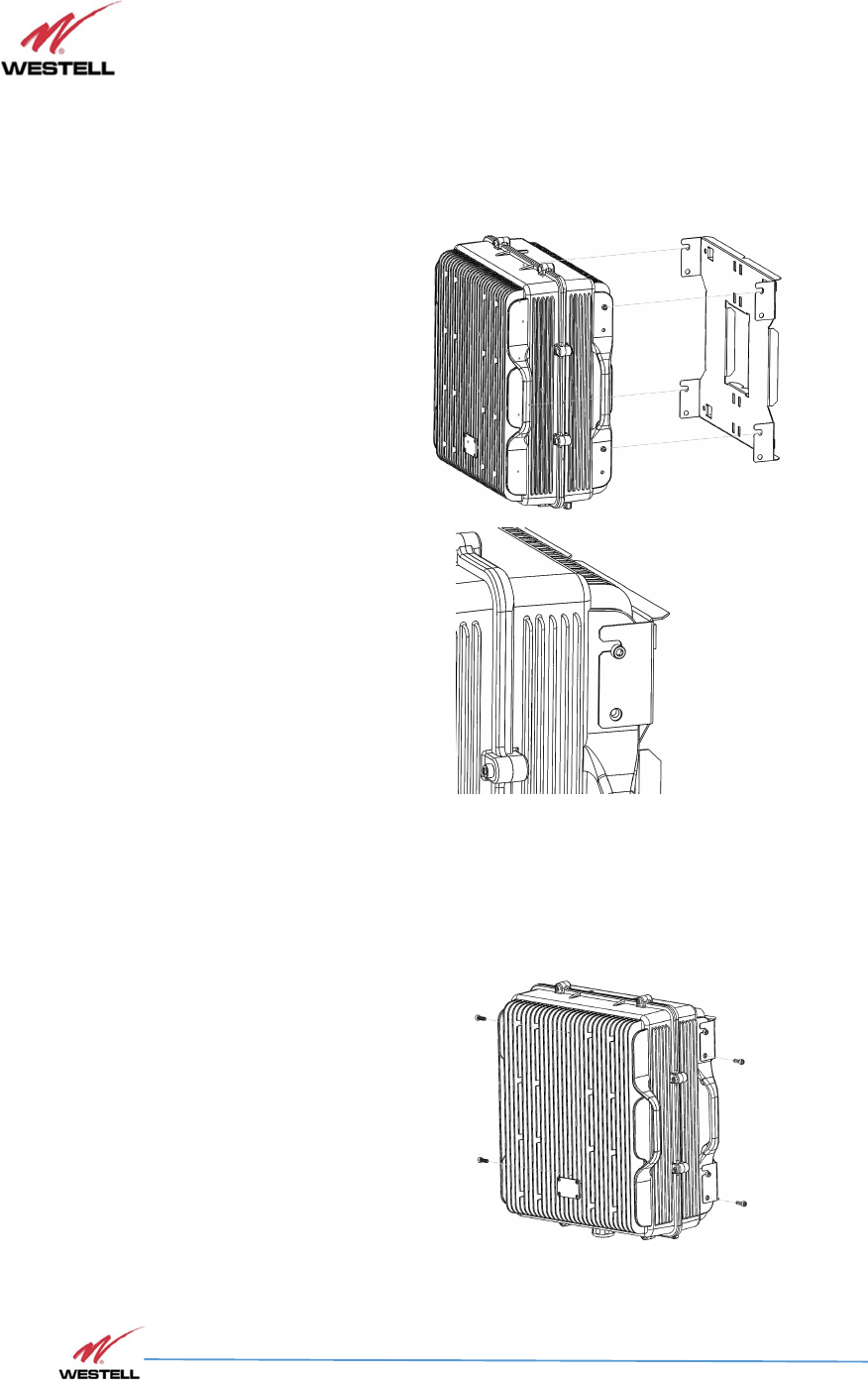
VHF Product Manual
July 2018, Rev B
WESTELL.COM
©2017 Westell Technologies July 2018; Doc No. VHF Signal Booster UM RA
1.877.844.4274 Page 27 of 95
B. After attaching the bracket hang the Signal Booster.
Figure:
Figure: Figure:
Figure:
Hang the Signal Booster
C. Secure the cabinet to the bracket.
To attach the Signal Booster’s cabinet to the bracket use the provided four M6 x 1/2” allen
screws and follow the indicated steps:
Figure:
Figure: Figure:
Figure:
Secure the cabinet to the bracket
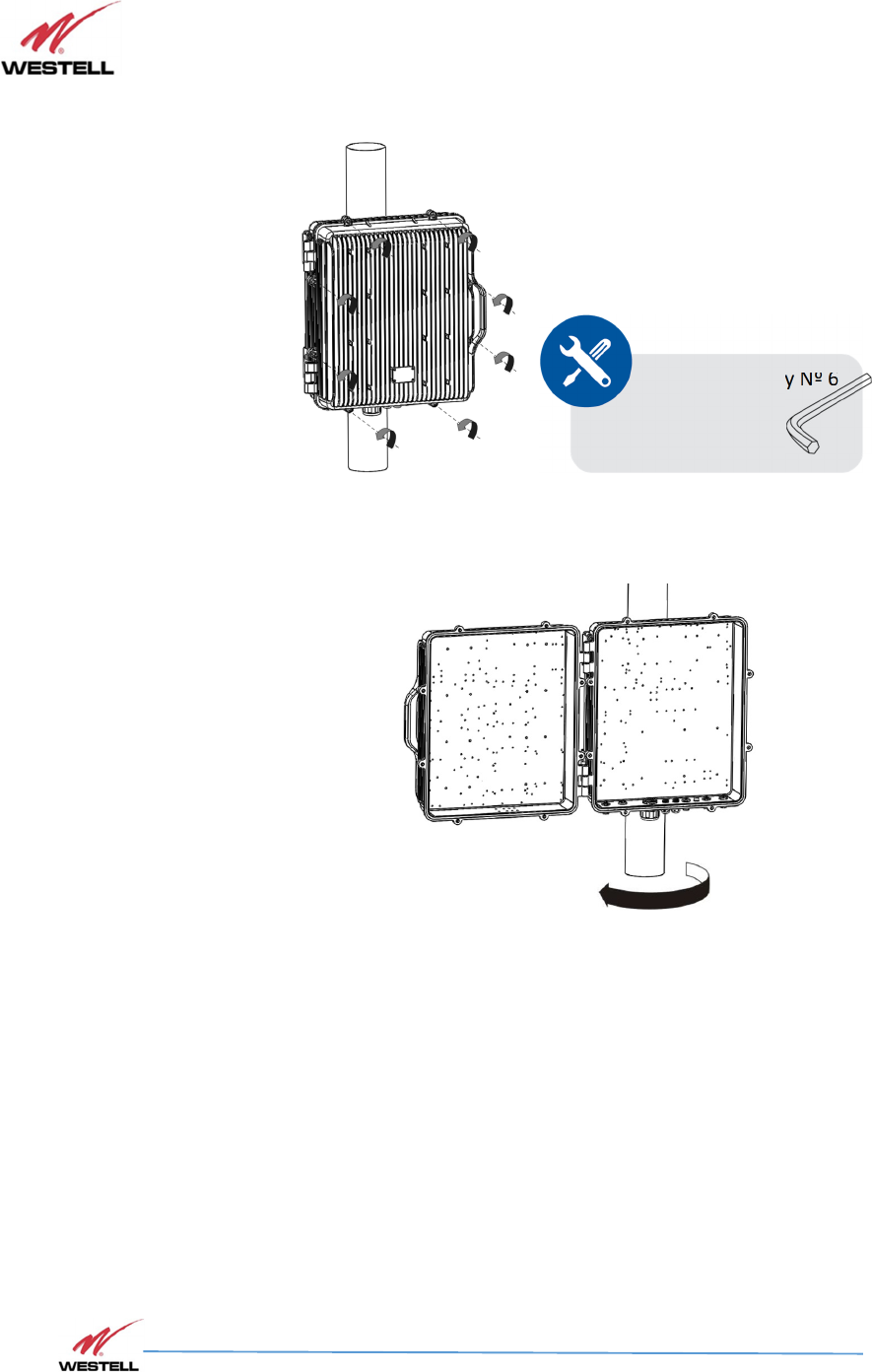
VHF Product Manual
July 2018, Rev B
WESTELL.COM
©2017 Westell Technologies July 2018; Doc No. VHF Signal Booster UM RA
1.877.844.4274 Page 28 of 95
D. To open the cabinet, release the 8 door screws using the provided special allen key.
Figure:
Figure: Figure:
Figure:
Release Signal Booster cover
Figure: Open the Signal Booster
TOOL TIPS
Use allen key Nº 6
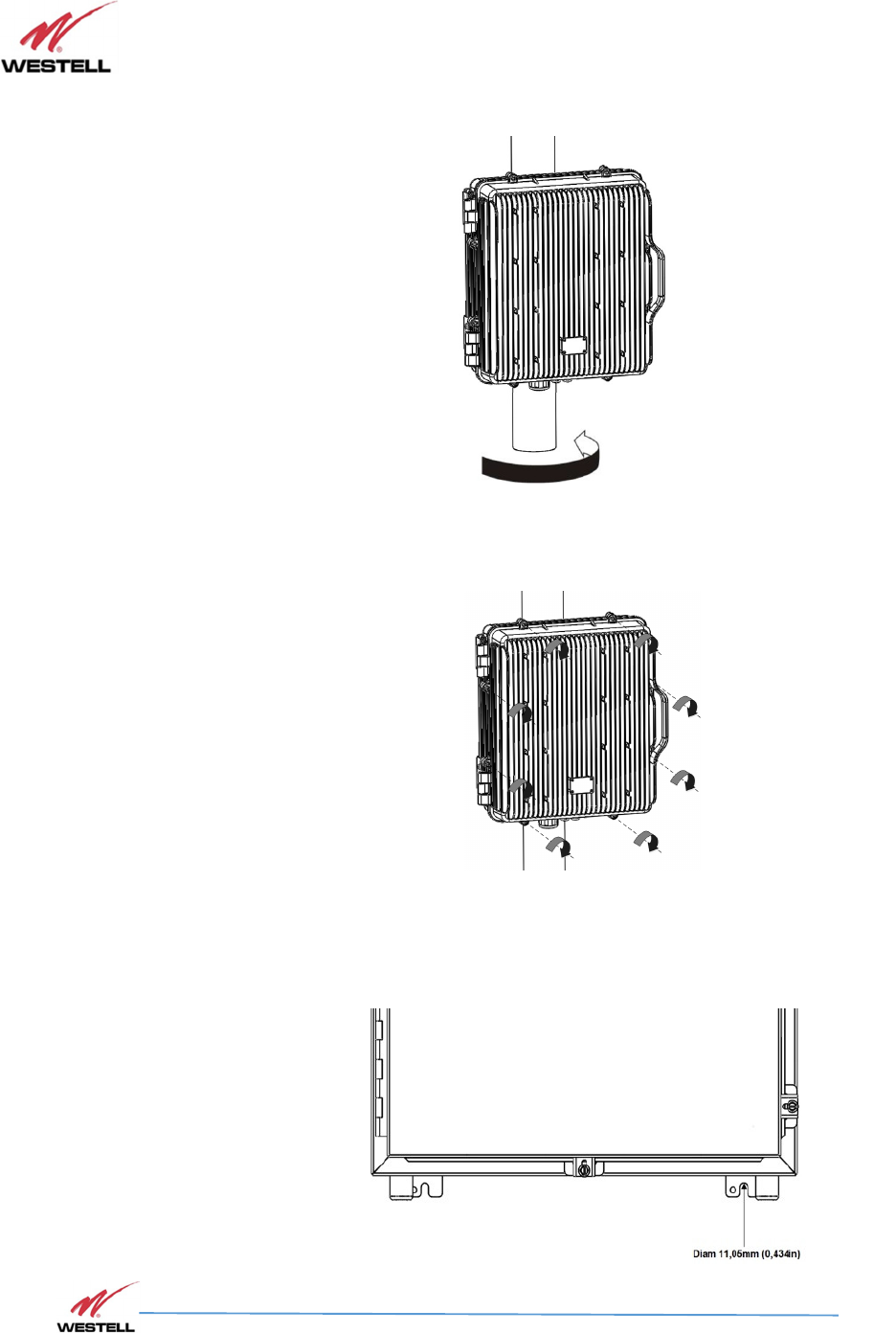
VHF Product Manual
July 2018, Rev B
WESTELL.COM
©2017 Westell Technologies July 2018; Doc No. VHF Signal Booster UM RA
1.877.844.4274 Page 29 of 95
Figure:
Figure: Figure:
Figure:
Close the Signal Booster
Figure:
Figure: Figure:
Figure:
Secure Signal Booster
Mounting Cabinet
Mounting Cabinet Mounting Cabinet
Mounting Cabinet WST021
WST021WST021
WST021
A. This cabinet can be mounted on a wall.
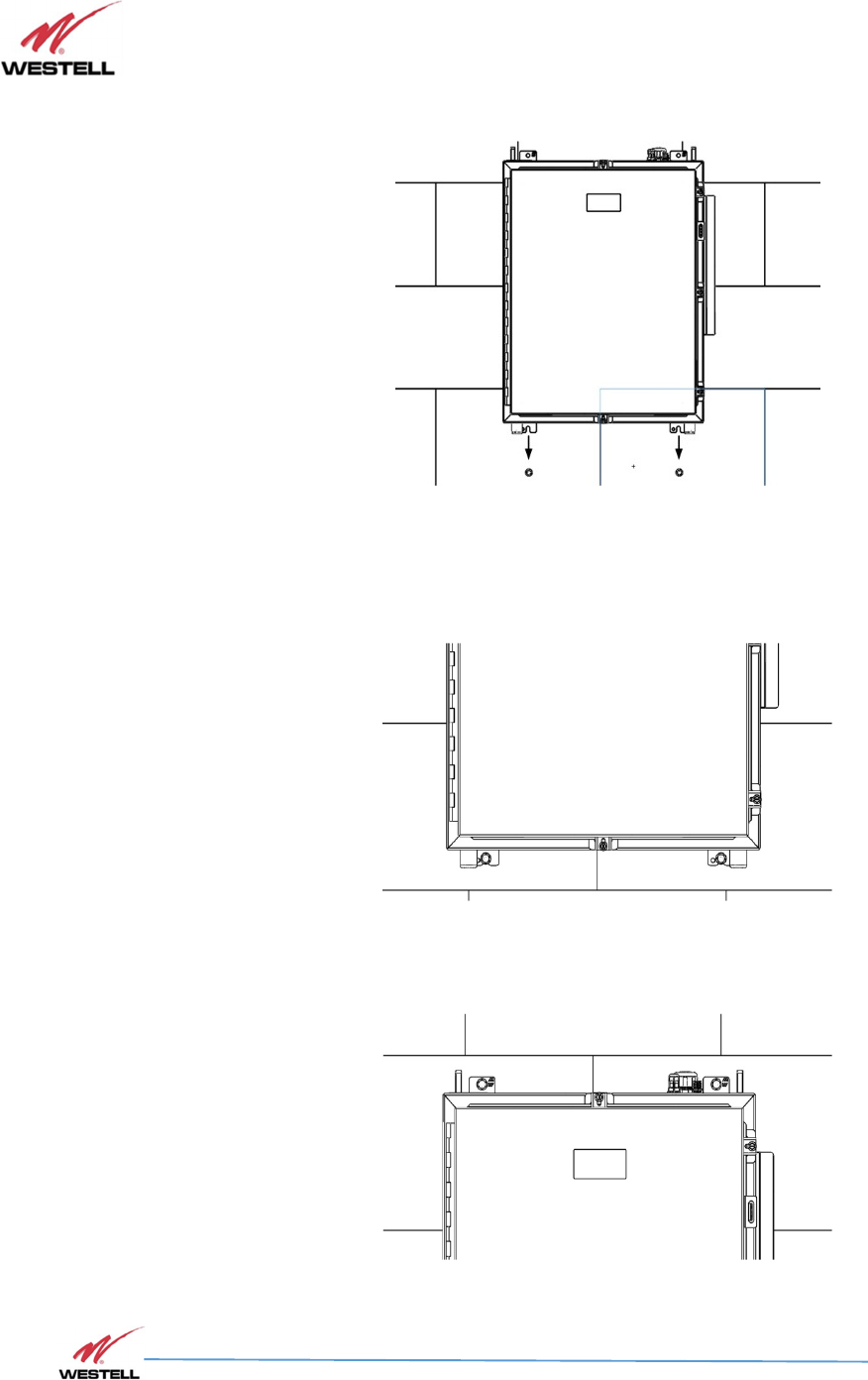
VHF Product Manual
July 2018, Rev B
WESTELL.COM
©2017 Westell Technologies July 2018; Doc No. VHF Signal Booster UM RA
1.877.844.4274 Page 30 of 95
Figure: Secure Signal Booster
Figure
FigureFigure
Figure:
: :
:
Hang the Signal Booster
Figure:
Figure: Figure:
Figure:
Secure Signal Booster cover
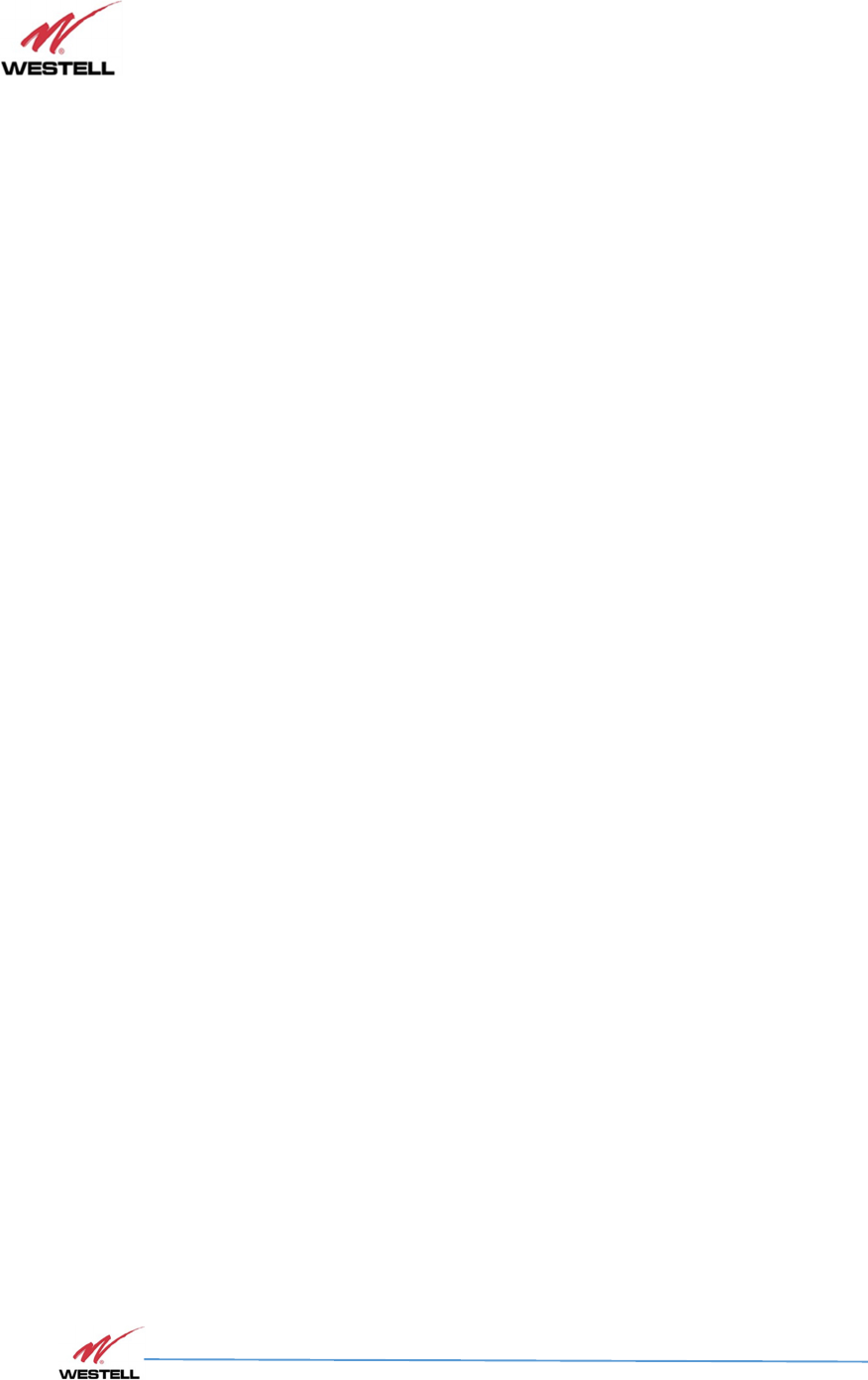
VHF Product Manual
July 2018, Rev B
WESTELL.COM
©2017 Westell Technologies July 2018; Doc No. VHF Signal Booster UM RA
1.877.844.4274 Page 31 of 95
Figure:
Figure: Figure:
Figure:
Secure Signal Booster cover
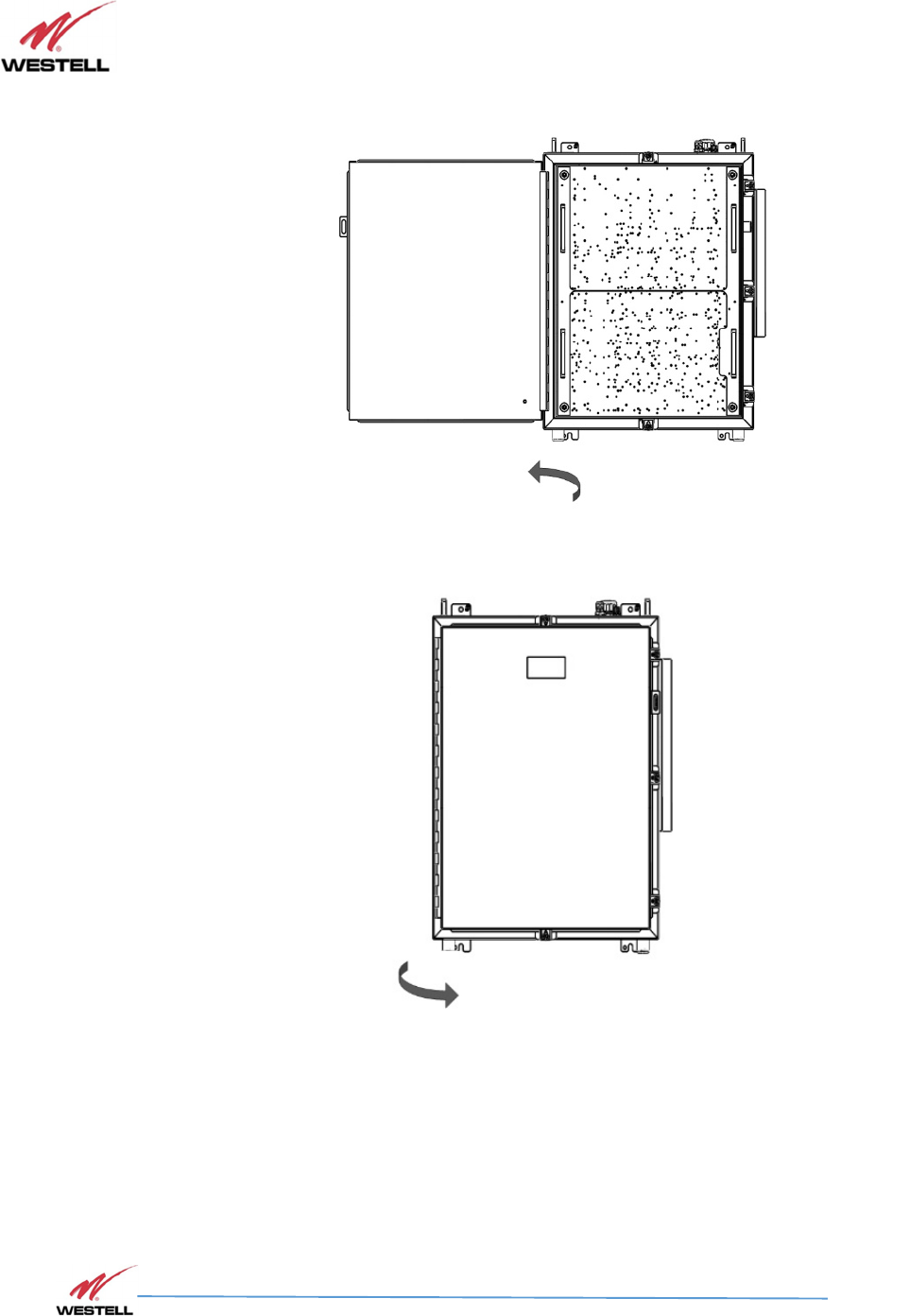
VHF Product Manual
July 2018, Rev B
WESTELL.COM
©2017 Westell Technologies July 2018; Doc No. VHF Signal Booster UM RA
1.877.844.4274 Page 32 of 95
B. To open the cabinet, release the door screws using a flat screw driver.
Figure:
Figure: Figure:
Figure:
Open the Signal Booster cover
Figure:
Figure: Figure:
Figure:
Close the Signal Booster cover
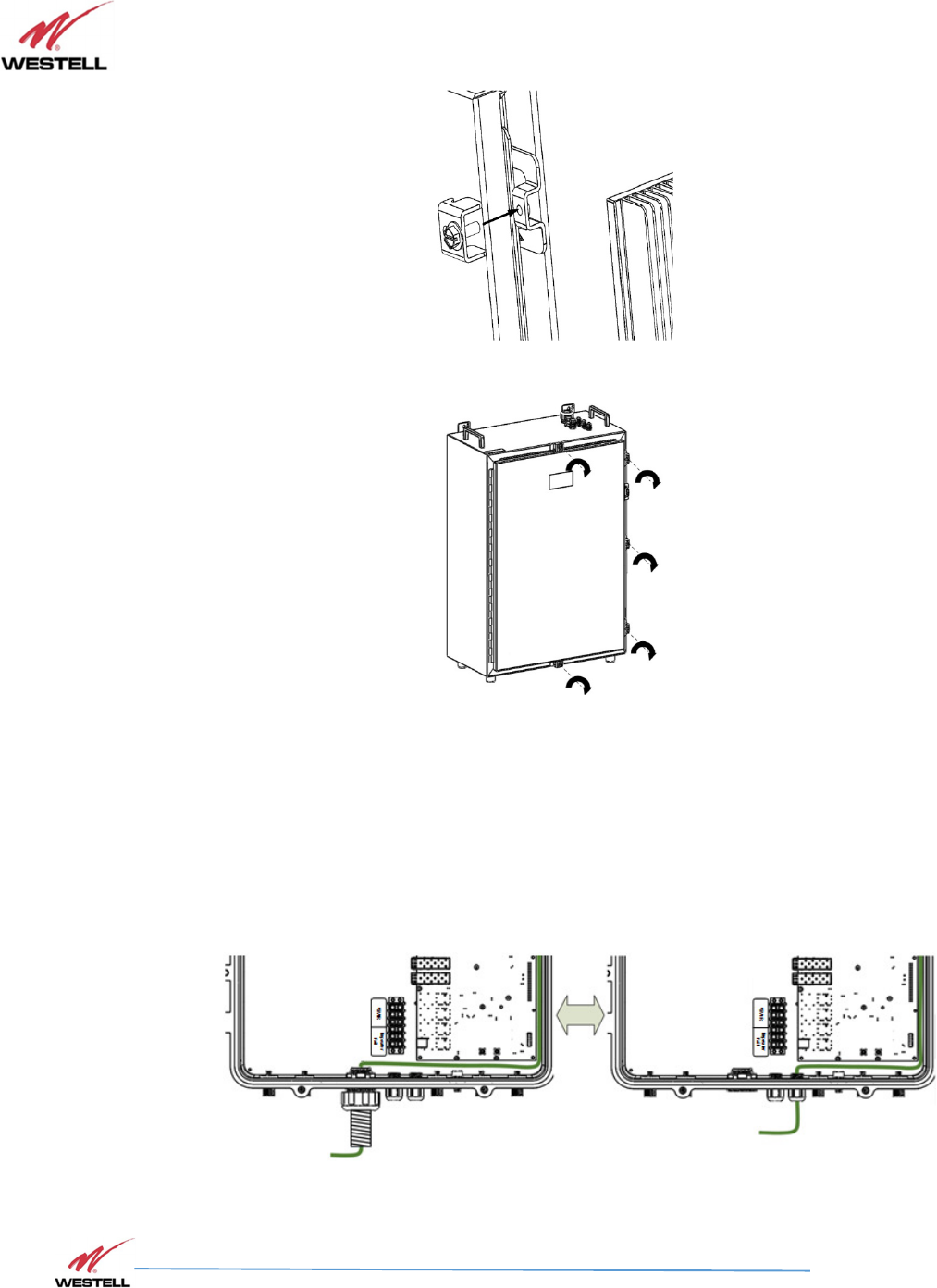
VHF Product Manual
July 2018, Rev B
WESTELL.COM
©2017 Westell Technologies July 2018; Doc No. VHF Signal Booster UM RA
1.877.844.4274 Page 33 of 95
Figure:
Figure: Figure:
Figure:
Secure Signal Booster cover
Figure:
Figure: Figure:
Figure:
Secure Signal Booster cover
Use of Liquid Tight Conduit
Use of Liquid Tight ConduitUse of Liquid Tight Conduit
Use of Liquid Tight Conduit
The unit has available a Liquid Tight Conduit Fitting connector for ¾” tubes. The unit as
standard has the connector installed, so if the user requires to use this connector, if
available, the NFPA cables, Ethernet, DC or AC cables can be routed through this
connector.
Figure:
Figure: Figure:
Figure:
AC Routing through cable gland or conduit connector
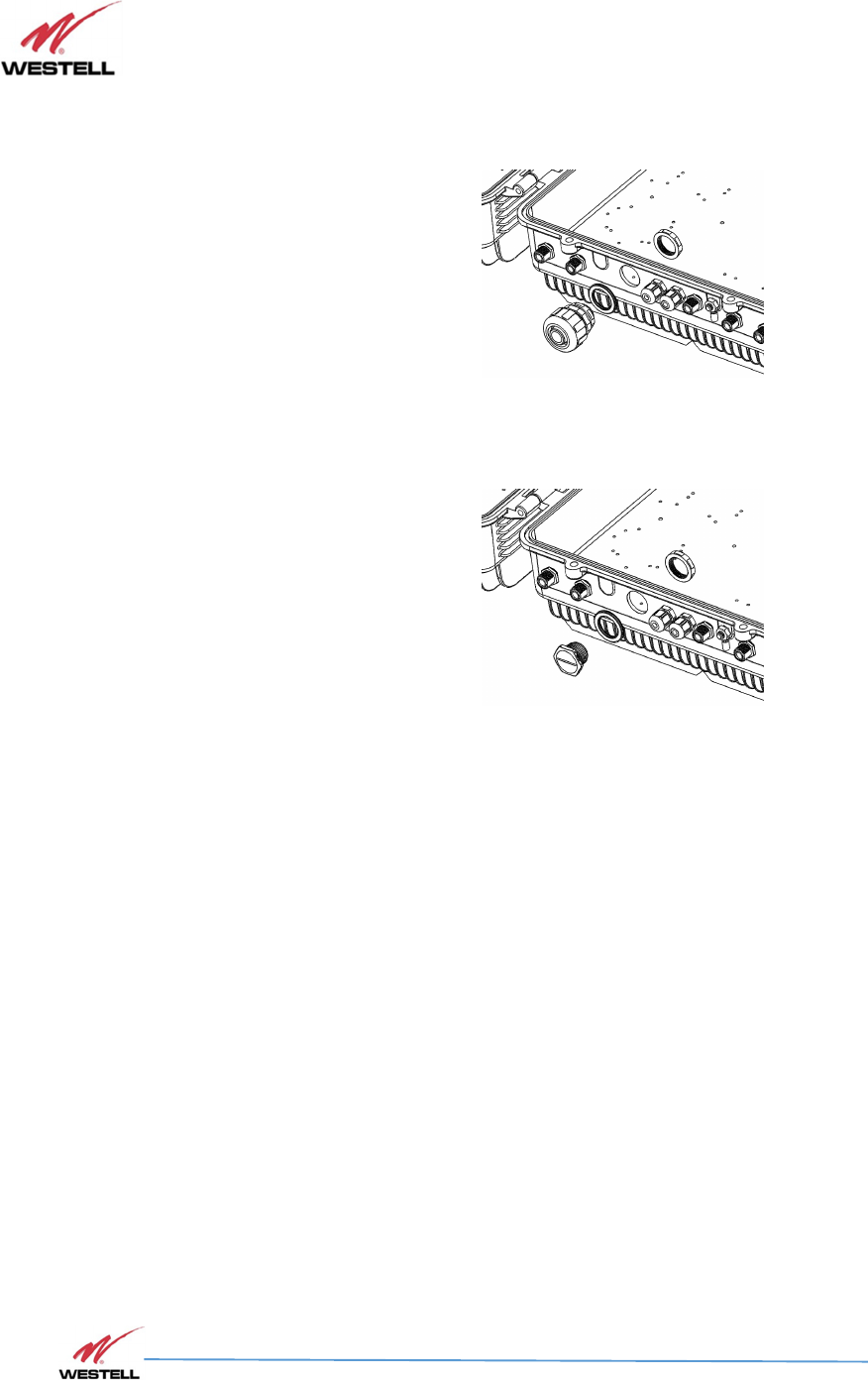
VHF Product Manual
July 2018, Rev B
WESTELL.COM
©2017 Westell Technologies July 2018; Doc No. VHF Signal Booster UM RA
1.877.844.4274 Page 34 of 95
If the is not going to use Liquid Tight Conduits, then the connector should be replaced by
the provided sealing cup.
Figure:
Figure: Figure:
Figure:
Remove the conduit connector
Figure:
Figure: Figure:
Figure:
Install the sealing cup
Replacement of Conduit connector to sealing cup
NEMA4 considerations
This device is equipped with a NEMA4 enclosure, however, to ensure the NEMA rating, the
user must have the following considerations:
1. Correct use of the Liquid Tight Conduit. In case this interface is not used, it should be
replaced with the sealing cup.
2. Sealing cups should be installed in the non-used cable glands.
3. The RF Ports should be perfectly mated.
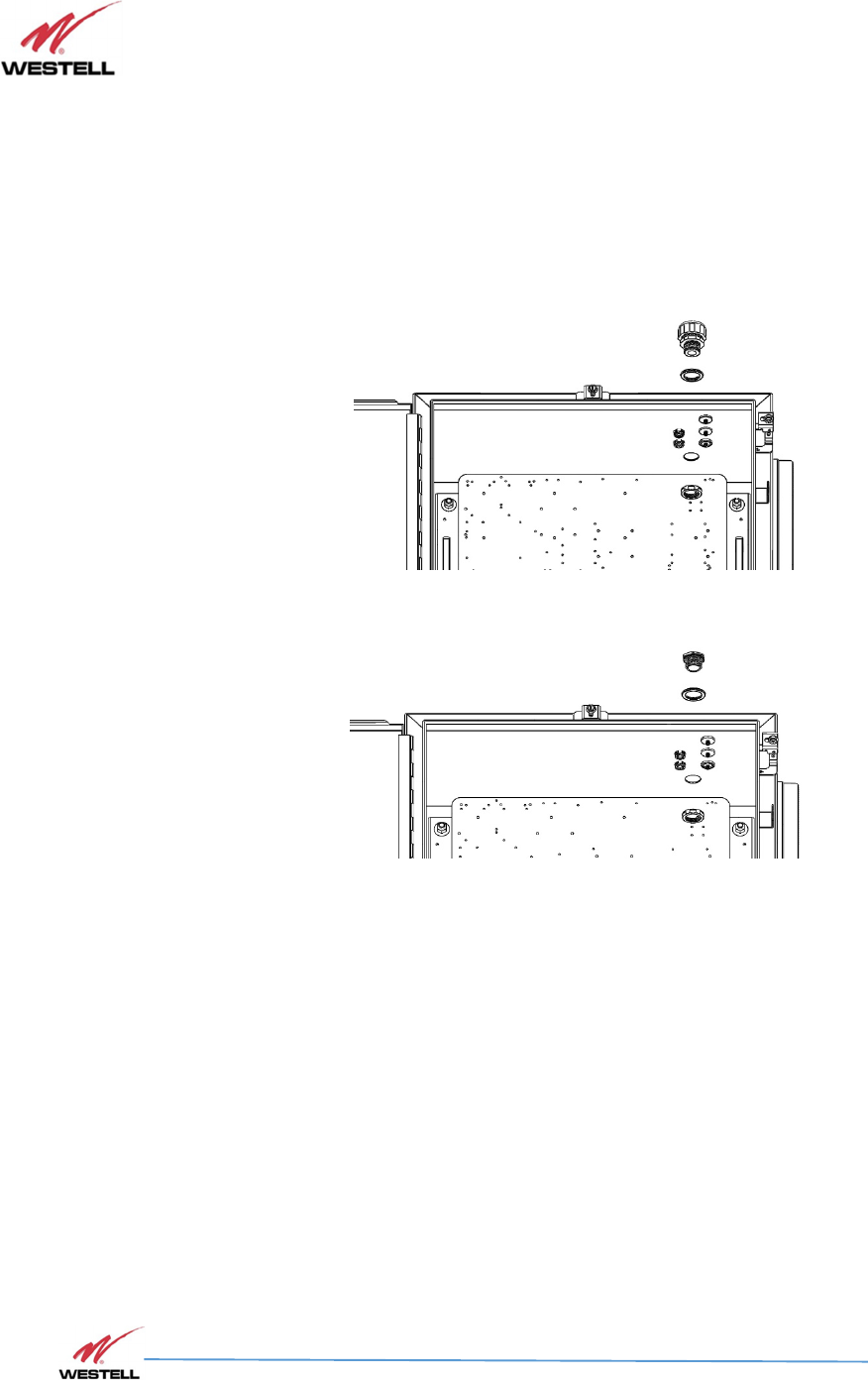
VHF Product Manual
July 2018, Rev B
WESTELL.COM
©2017 Westell Technologies July 2018; Doc No. VHF Signal Booster UM RA
1.877.844.4274 Page 35 of 95
Mounting Cabinet
Mounting Cabinet Mounting Cabinet
Mounting Cabinet WST021
WST021WST021
WST021
The unit has available a Liquid Tight Conduit Fitting connector for ¾” tubes. The unit as
standard has the connector installed, so if the user requires to use this connector, if
available, the NFPA cables, Ethernet, DC or AC cables can be routed through this connector.
If the is not going to use Liquid Tight Conduits, then the connector should be replaced by
the provided sealing cup.
Figure:
Figure: Figure:
Figure:
Remove the conduit connector
Figure
FigureFigure
Figure:
: :
:
Install the sealing cup
Replacement of Conduit connector to sealing cup
NEMA4 considerations
This device is equipped with a NEMA4 enclosure, however, to ensure the NEMA rating, the
user must have the following considerations:
1. Correct use of the Liquid Tight Conduit. In case this interface is not used, it should be
replaced with the sealing cup.
2. Sealing cups should be installed in the non-used cable glands.
3. The RF Ports should be perfectly mated.
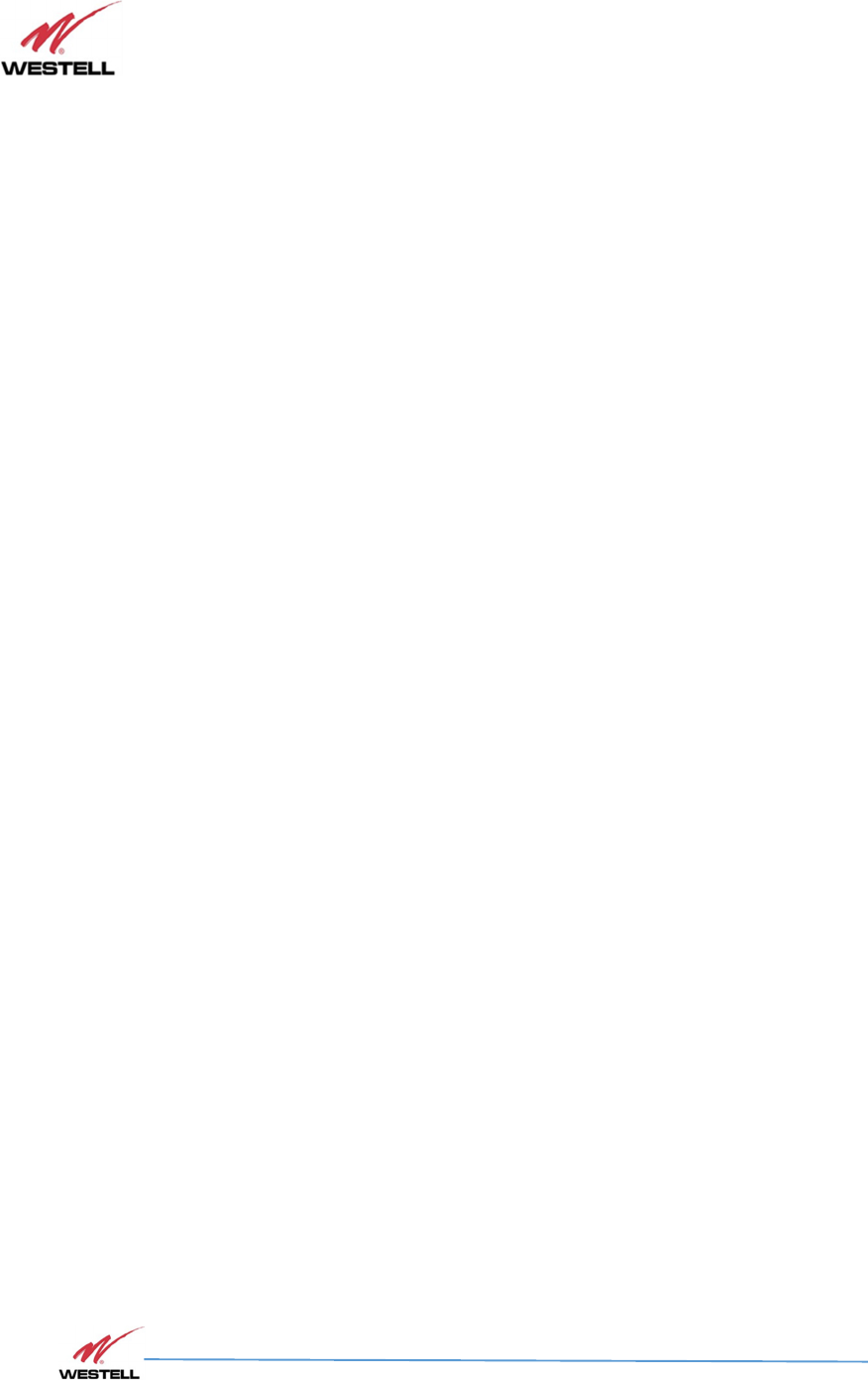
VHF Product Manual
July 2018, Rev B
WESTELL.COM
©2017 Westell Technologies July 2018; Doc No. VHF Signal Booster UM RA
1.877.844.4274 Page 36 of 95
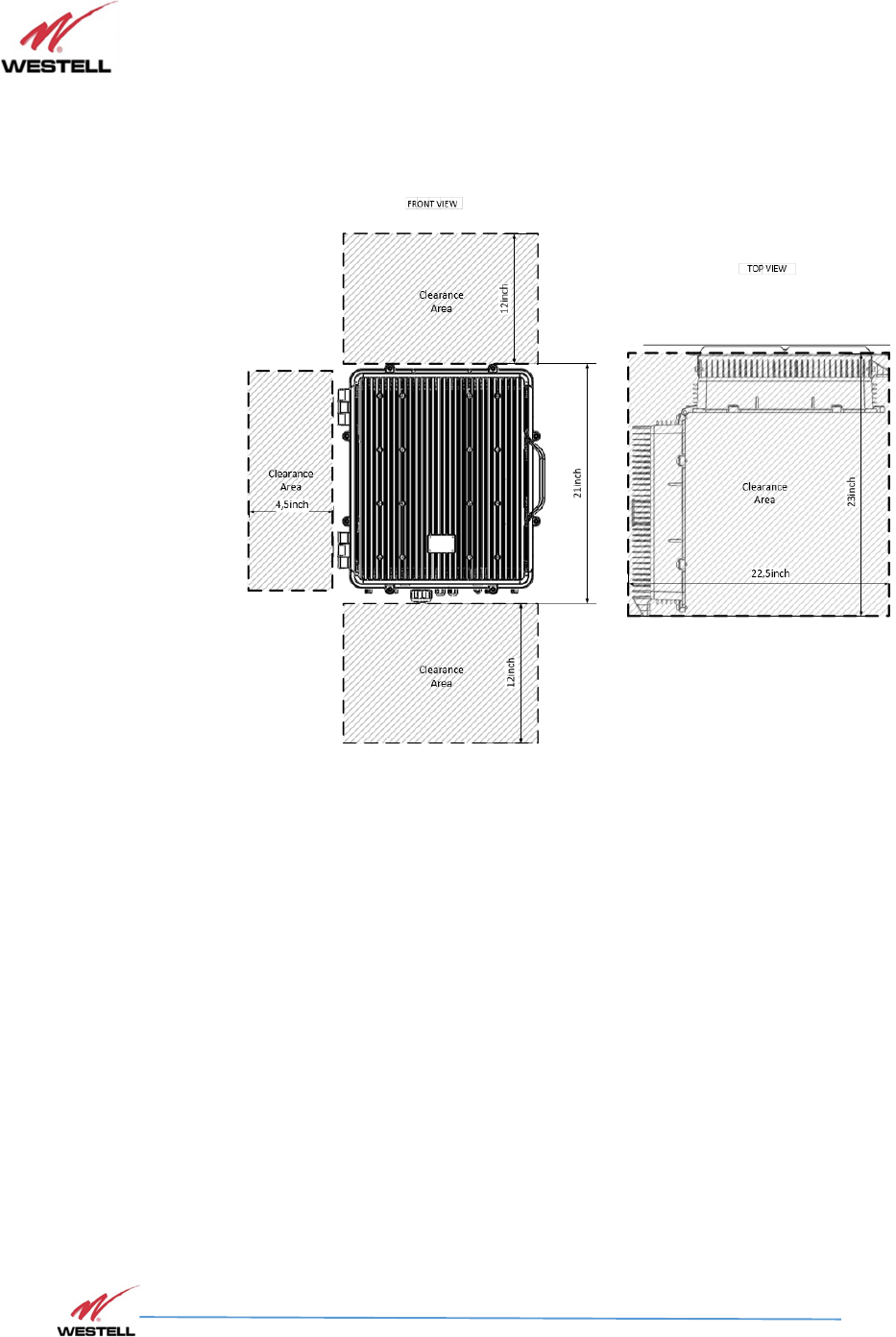
VHF Product Manual
July 2018, Rev B
WESTELL.COM
©2017 Westell Technologies July 2018; Doc No. VHF Signal Booster UM RA
1.877.844.4274 Page 37 of 95
Mounting clearance
Mounting clearanceMounting clearance
Mounting clearance
When mounting the cabinet, the clearances around it should be considered to allow a clear
open door and heat dissipation.
Figure: Mounting clearance WST012
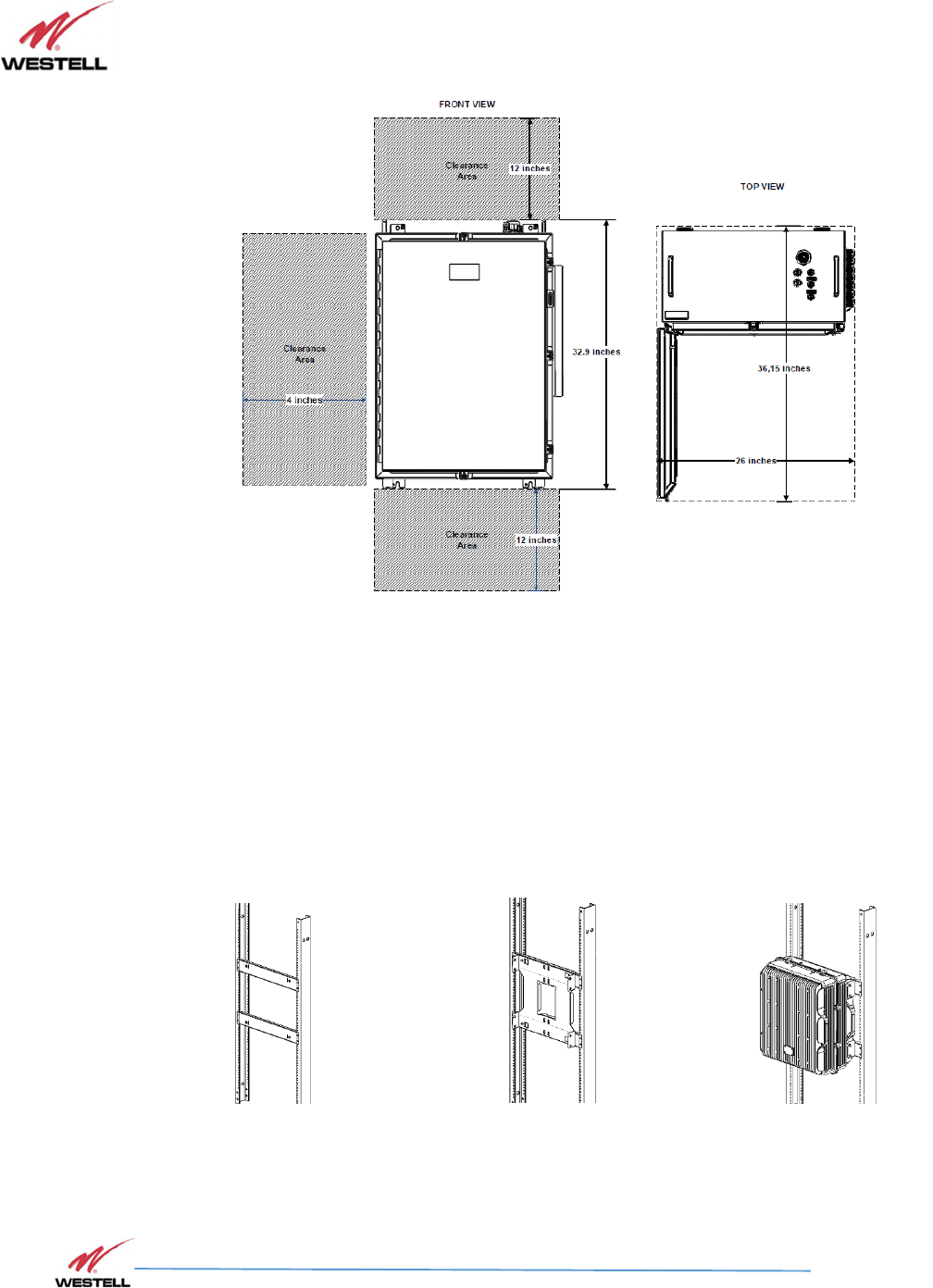
VHF Product Manual
July 2018, Rev B
WESTELL.COM
©2017 Westell Technologies July 2018; Doc No. VHF Signal Booster UM RA
1.877.844.4274 Page 38 of 95
Figure:
Figure: Figure:
Figure:
Mounting clearance WST021
Rack mount option
Rack mount optionRack mount option
Rack mount option
Even though this cabinet is designed mainly to be wall or pole mounted, it has the option to be
installed in a 19” standard rack using the Rack Mount Option.
The Rack Mount Option are adaptors that allow the installation of the cabinet bracket to the 19”
rack.
It is recommended to use 2 post racks, this way, using back-to-back installation, 4 cabinets can
be installed in a single 2 post RU rack.
Mount the 19” rack
adaptors.
Mount the cabinet
bracket to the adaptors.
Mount and Fix the Signal
Booster to the bracket.
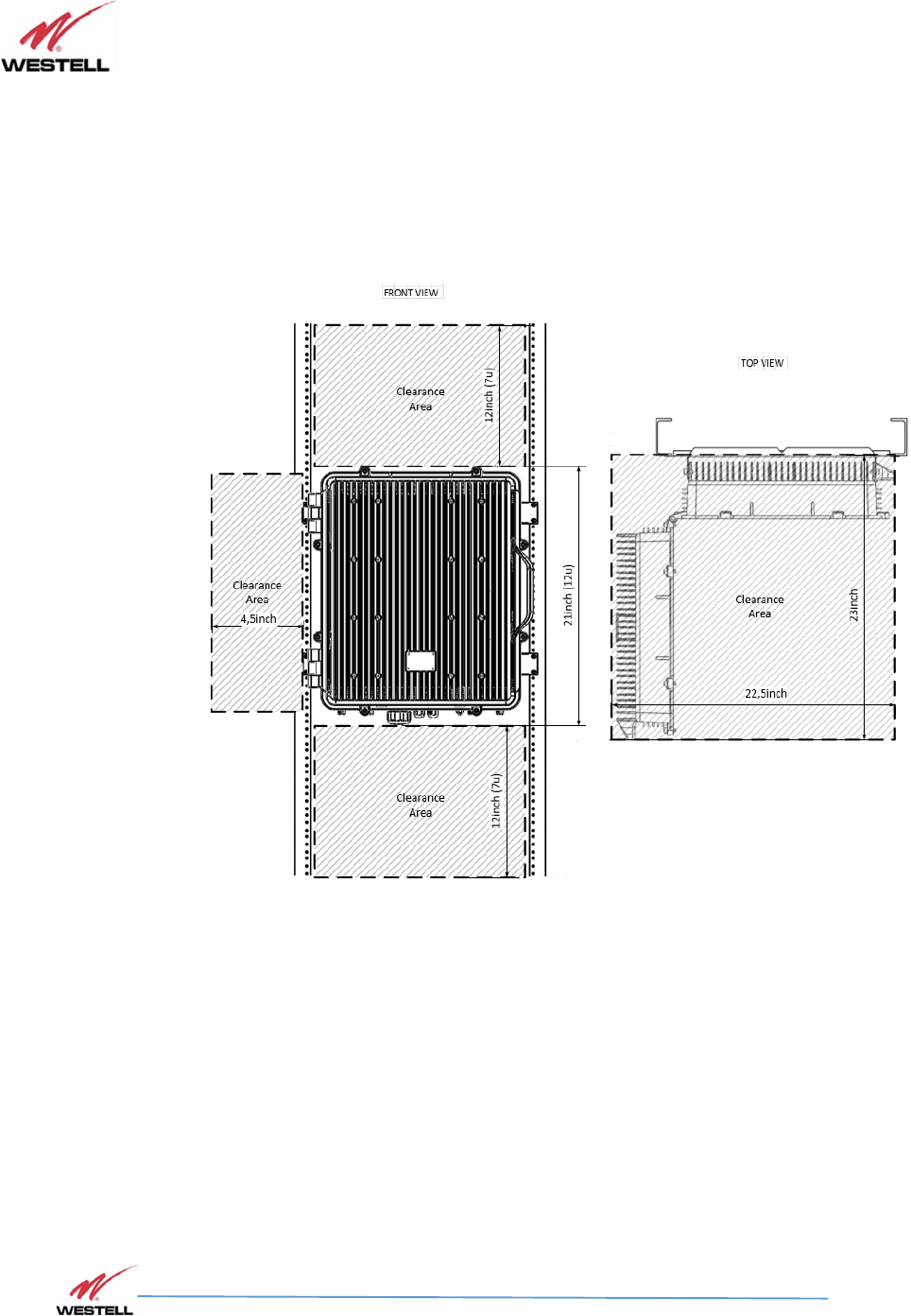
VHF Product Manual
July 2018, Rev B
WESTELL.COM
©2017 Westell Technologies July 2018; Doc No. VHF Signal Booster UM RA
1.877.844.4274 Page 39 of 95
Figure:
Figure: Figure:
Figure:
Installation steps for the rack mount option WST012
Mounting clearance on rack mount option
Mounting clearance on rack mount optionMounting clearance on rack mount option
Mounting clearance on rack mount option
When mounting the cabinet in a 19” rack, the clearances around it should be considered to
allow a clear open door and heat dissipation.
Figure:
Figure:Figure:
Figure:
Mounting clearance for the rack mount option WST012
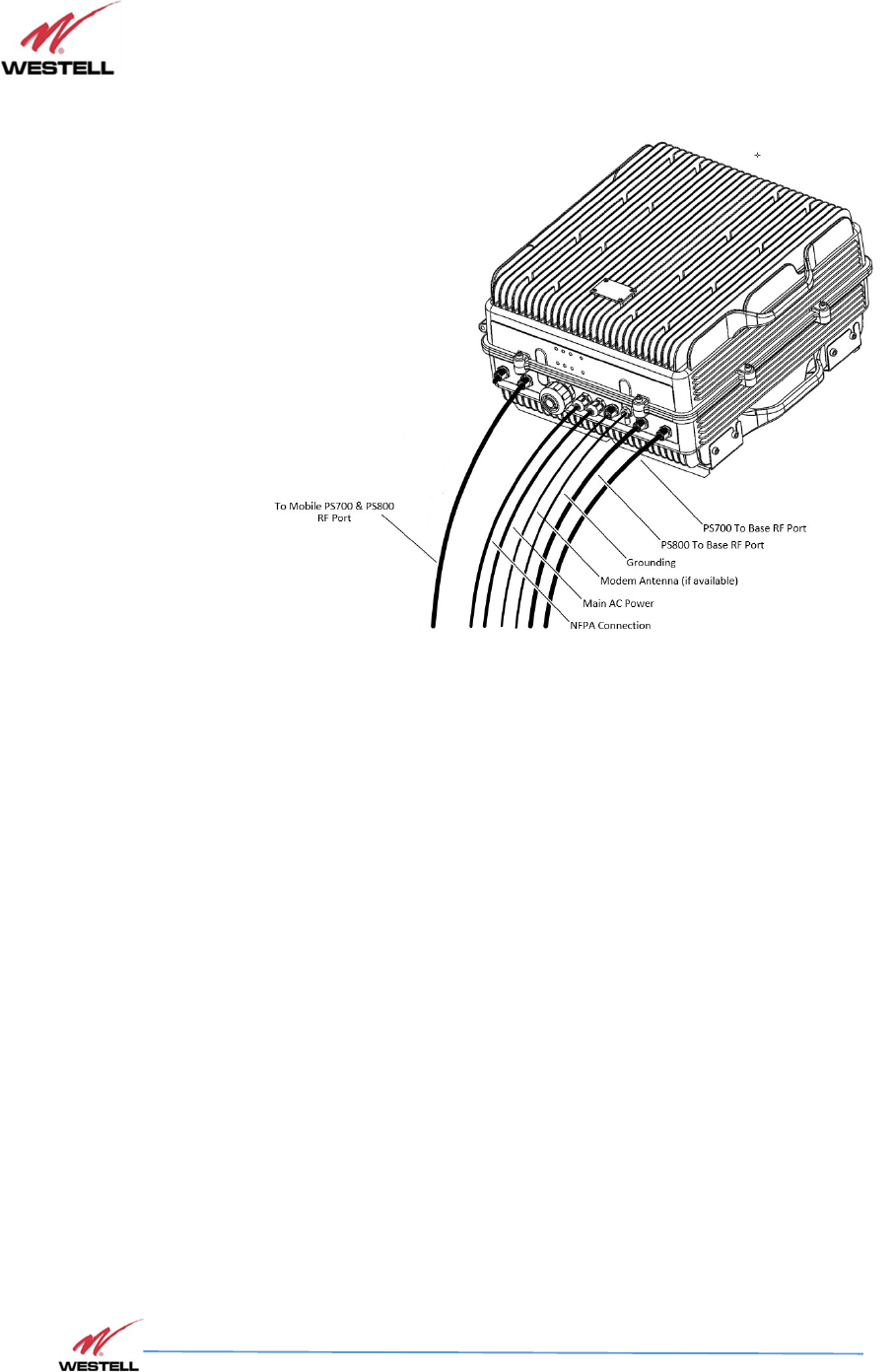
VHF Product Manual
July 2018, Rev B
WESTELL.COM
©2017 Westell Technologies July 2018; Doc No. VHF Signal Booster UM RA
1.877.844.4274 Page 40 of 95
6 Connecting the Signal Booster
Figure:
Figure: Figure:
Figure:
RF ports and Power Cable Glands location
6.1
6.1 6.1
6.1 Connection step by step
Connection step by stepConnection step by step
Connection step by step
A. RF Ports: Connect the service antennas to the To Mobile Port and each PS700 and PS800 donor
antennas to the To Base RF Ports. N type female connectors are used in this Signal Booster.
B. Once the RF ports of the Signal Booster are properly loaded connect the Main AC power. If using the
AC model, electrical installation must provide differential and thermo-magnetic breaker elements
according to electric safety international regulations.
C. Make sure that not used cable glands are properly sealed. For this, use the seal plug and self-amalgam
ating tape.
D. Auxiliary DC connection can be provided to the device from an external DC source. There is a dedicate
d port for this purpose, and a dedicated DC connector labelled “VDC IN” located inside the cabinet. Plea
se check appropriate DC voltage at Signal Booster specification sheet.
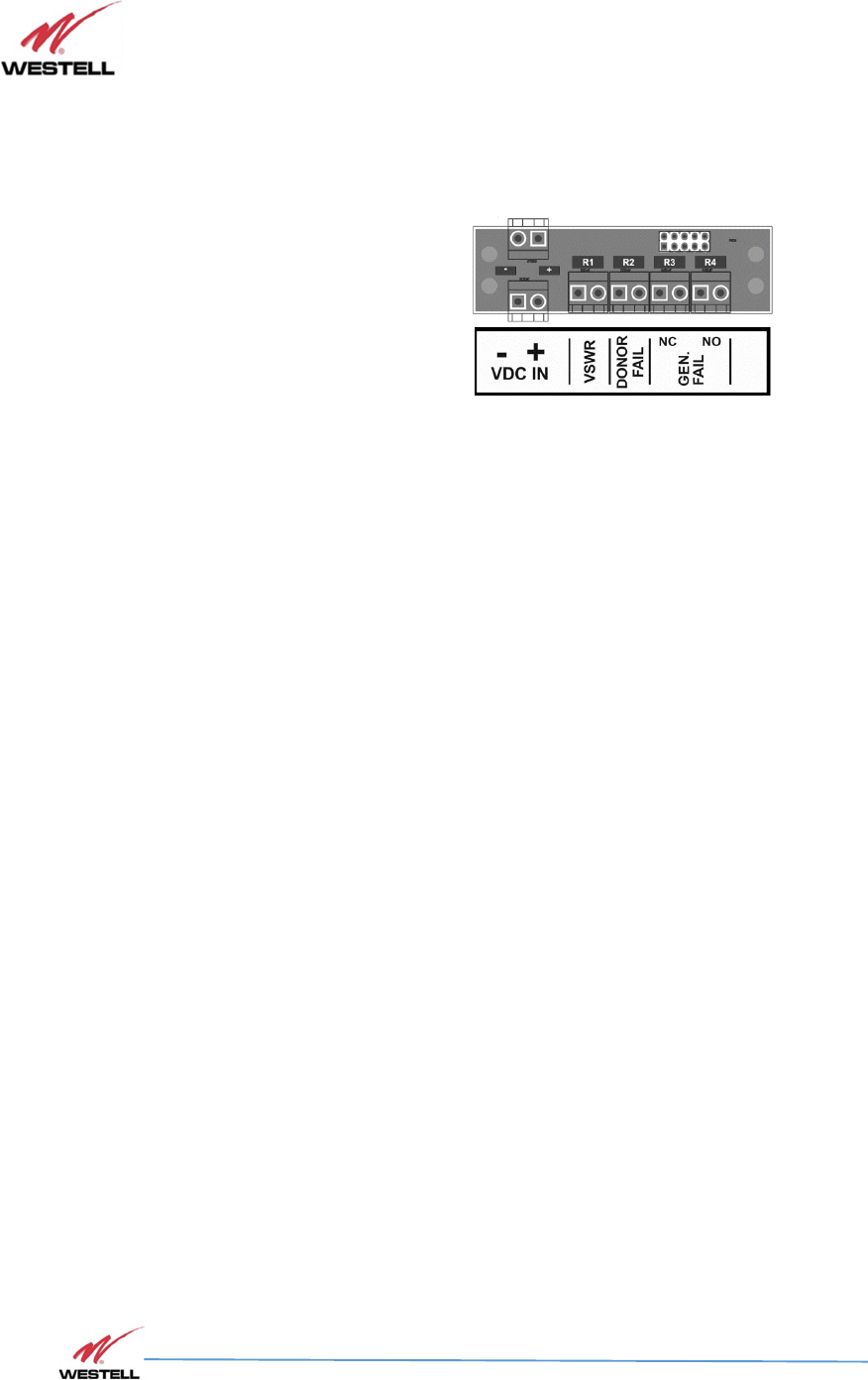
VHF Product Manual
July 2018, Rev B
WESTELL.COM
©2017 Westell Technologies July 2018; Doc No. VHF Signal Booster UM RA
1.877.844.4274 Page 41 of 95
E. NFPA Dry Contacts: there is a dedicated cable gland for this purpose. A multi-conductor cable can be
used to connect the NFPA dry contacts to the Fire Department Control Box.
Figure:
Figure: Figure:
Figure:
NFPA Dry Contact connection location inside the cabinet
F. Once the Signal Booster is connected to the power source, it takes about 40 seconds to run a booting
routine. After that time, the Signal Booster is ready to be connected via USB cable to a computer
running Westell Control Software (WCS) to be properly configured.
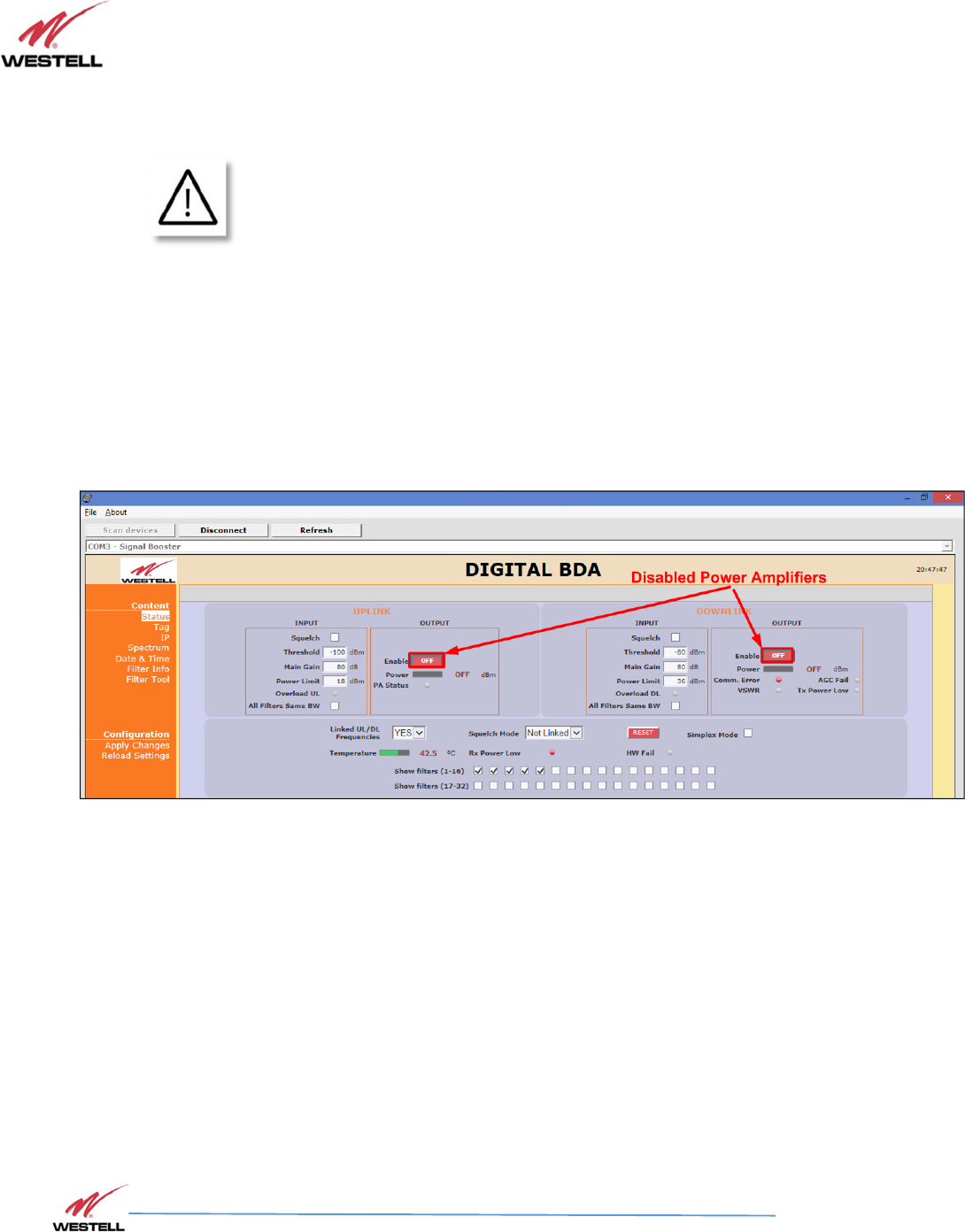
VHF Product Manual
July 2018, Rev B
WESTELL.COM
©2017 Westell Technologies July 2018; Doc No. VHF Signal Booster UM RA
1.877.844.4274 Page 42 of 95
7 System Operation
BE SURE THAT “TO MOBILE” AND “TO BASE” PORTS ARE PROPERLY LOADED
EITHER WITH 50 OHMS DUMMY LOADS, OR RADIATING SYSTEM.
The Digital Signal Booster may come in one out of two versions: a 32 narrow-band filters version or an
up-to-8 adjustable-bandwidth filters version. It is even possible to have both versions in one device so
that the user can choose either of them. Depending on which version is actually running, the main
screen of the Westell Control Software will have a slightly different look.
1. Turn on the Digital Signal Booster, connect computer to Signal Booster through Ethernet or USB cable,
and run Westell Control Software. It is recommend to turn off the power amplifiers.
PA OFF in narrow-band version
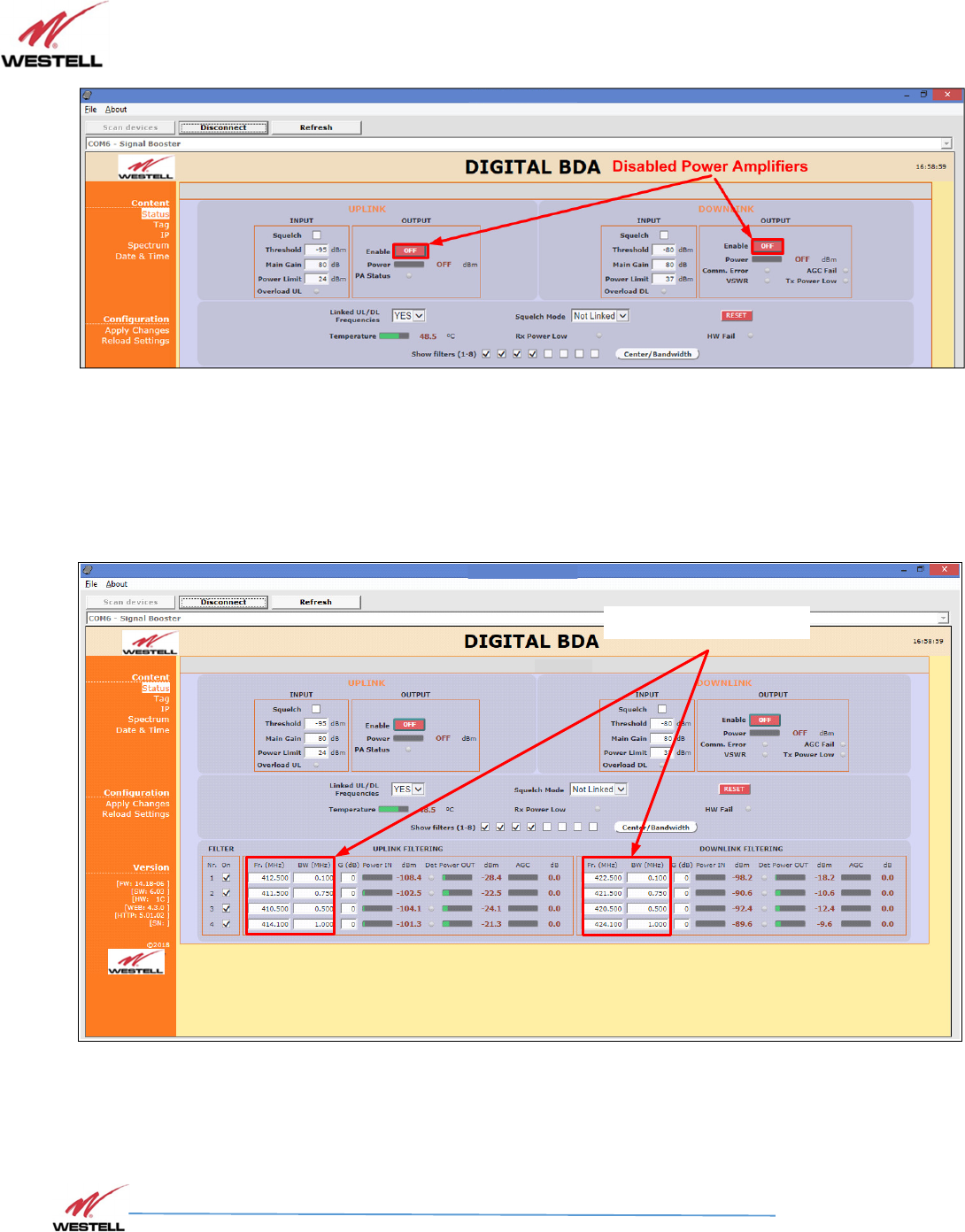
VHF Product Manual
July 2018, Rev B
WESTELL.COM
©2017 Westell Technologies July 2018; Doc No. VHF Signal Booster UM RA
1.877.844.4274 Page 43 of 95
PA OFF in adjustable bandwidth version
2. Setup desired channel frequencies. Since Westell Signal Booster is channel selective, user has to know
what frequencies are used in base station.
Narrow-band filter frequency settings
Program frequencies and
bandwidths
Frequency and Bandwidth settings
3. Turn on UL and DL power amplifiers, and check that any alarm indicator is active.
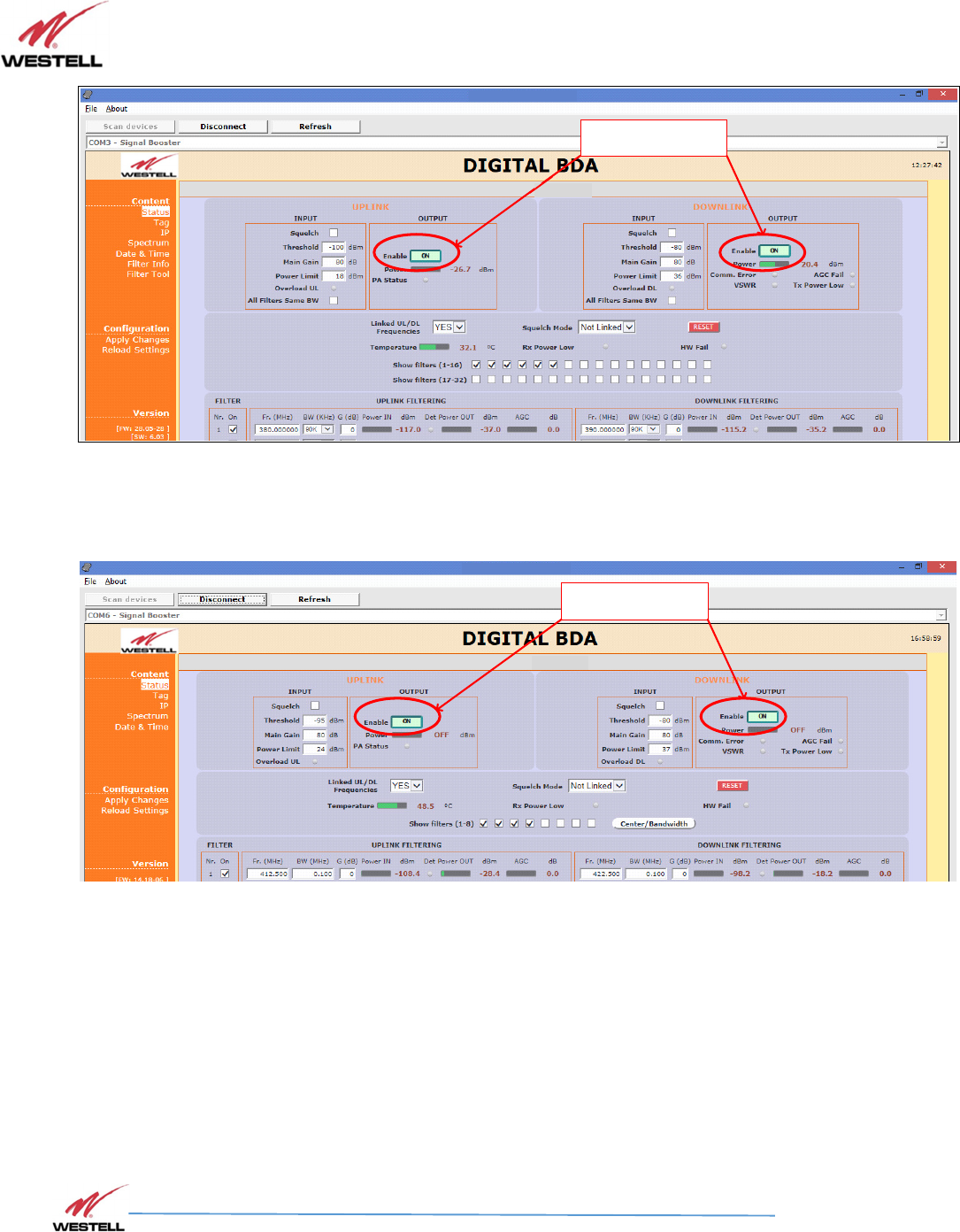
VHF Product Manual
July 2018, Rev B
WESTELL.COM
©2017 Westell Technologies July 2018; Doc No. VHF Signal Booster UM RA
1.877.844.4274 Page 44 of 95
TURN ON POWER
AMPLIFIERS
PA ON in narrow band version
TURN ON POWER
AMPLIFIERS
PA ON in adjustable bandwidth version
4. Setup desired operating gain using FCS. UL and DL chain are independent, so both values must be set.
To set DL band gain is recommended that AGC works around 3dB in each channel, in this way, maximum
output power is achieved.
5. Set up squelch settings. Controls are independent in UL and DL bands. Typical values for UL are -
110dBm for squelch threshold. For DL, recommended value for squelch threshold is minimum level
received in any active channel minus 10dB.
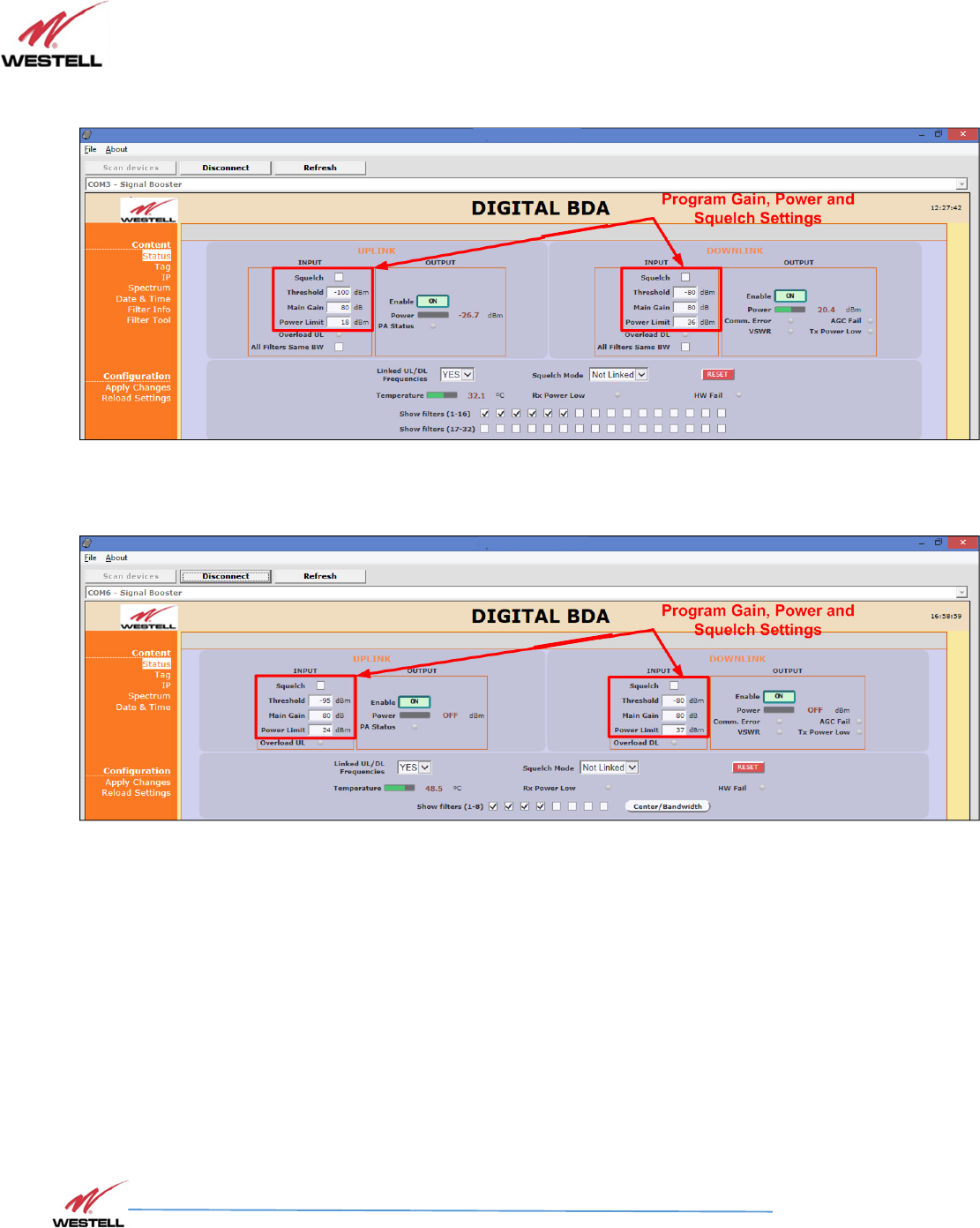
VHF Product Manual
July 2018, Rev B
WESTELL.COM
©2017 Westell Technologies July 2018; Doc No. VHF Signal Booster UM RA
1.877.844.4274 Page 45 of 95
Squelch, gain and power settings: narrow band
Squelch, gain and power settings: adjustable bandwidth
6. For narrow band filters version, setup desired filter bandwidth, depending on presence of adjacent
channels. In principle, recommended bandwidth filter is 90KHz due to its low delay, but if adjacent signal
is detected, narrow filters can be used. Spectrum analyzer of FCS can be used to know rejection to
undesired signals. It is recommend that adjacent channels output power be, at least, 10dBc lower than
useful carrier.
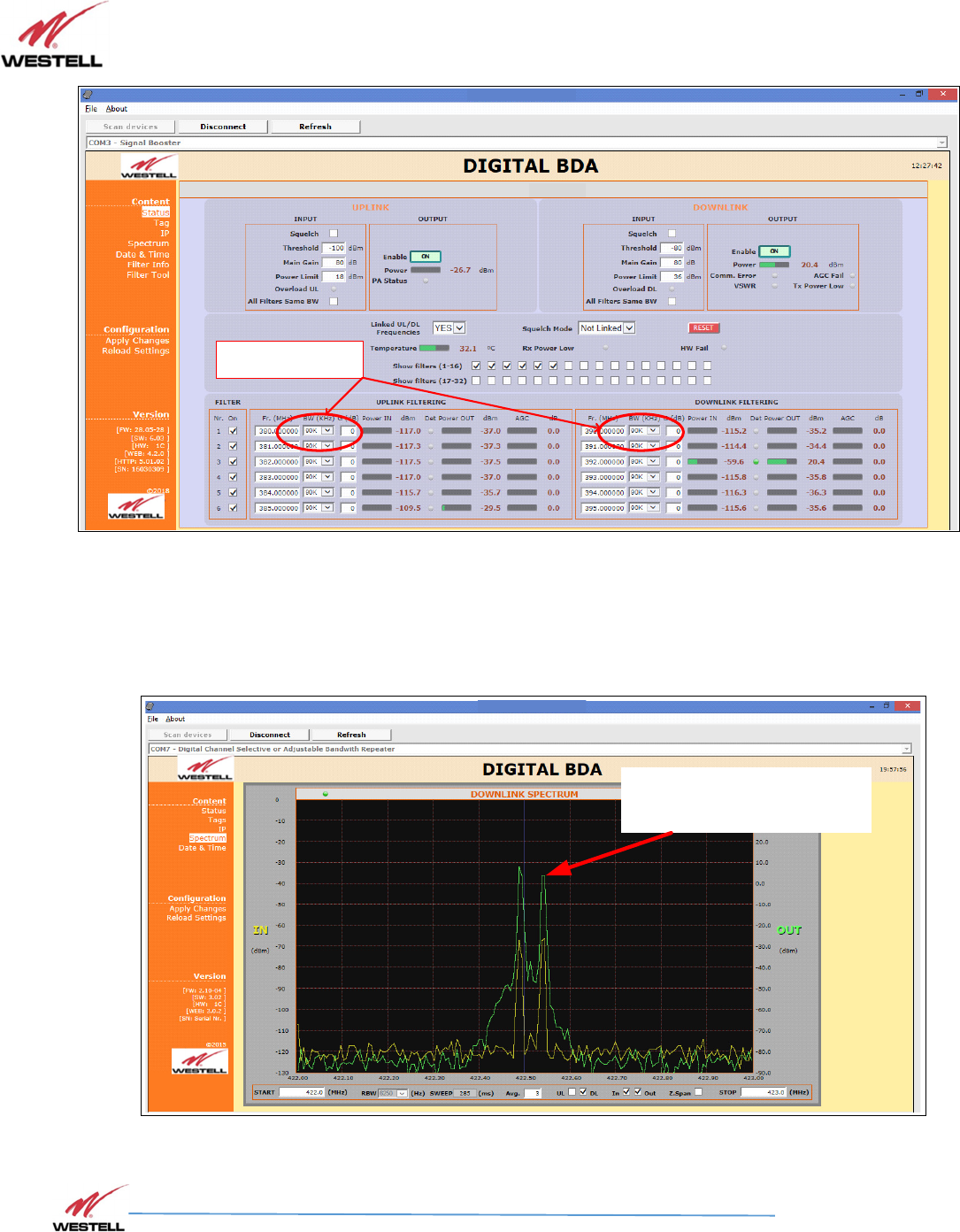
VHF Product Manual
July 2018, Rev B
WESTELL.COM
©2017 Westell Technologies July 2018; Doc No. VHF Signal Booster UM RA
1.877.844.4274 Page 46 of 95
PROGRAM FILTER
BANDWIDTH
Filter bandwidth selection for narrow band filters version
Next figures, shows how integrated spectrum analyzer can help to select bandwidth filters:
Poorly rejected adjacent
channel with 90KHz filter
Adjacent channel rejection with 90KHz filter
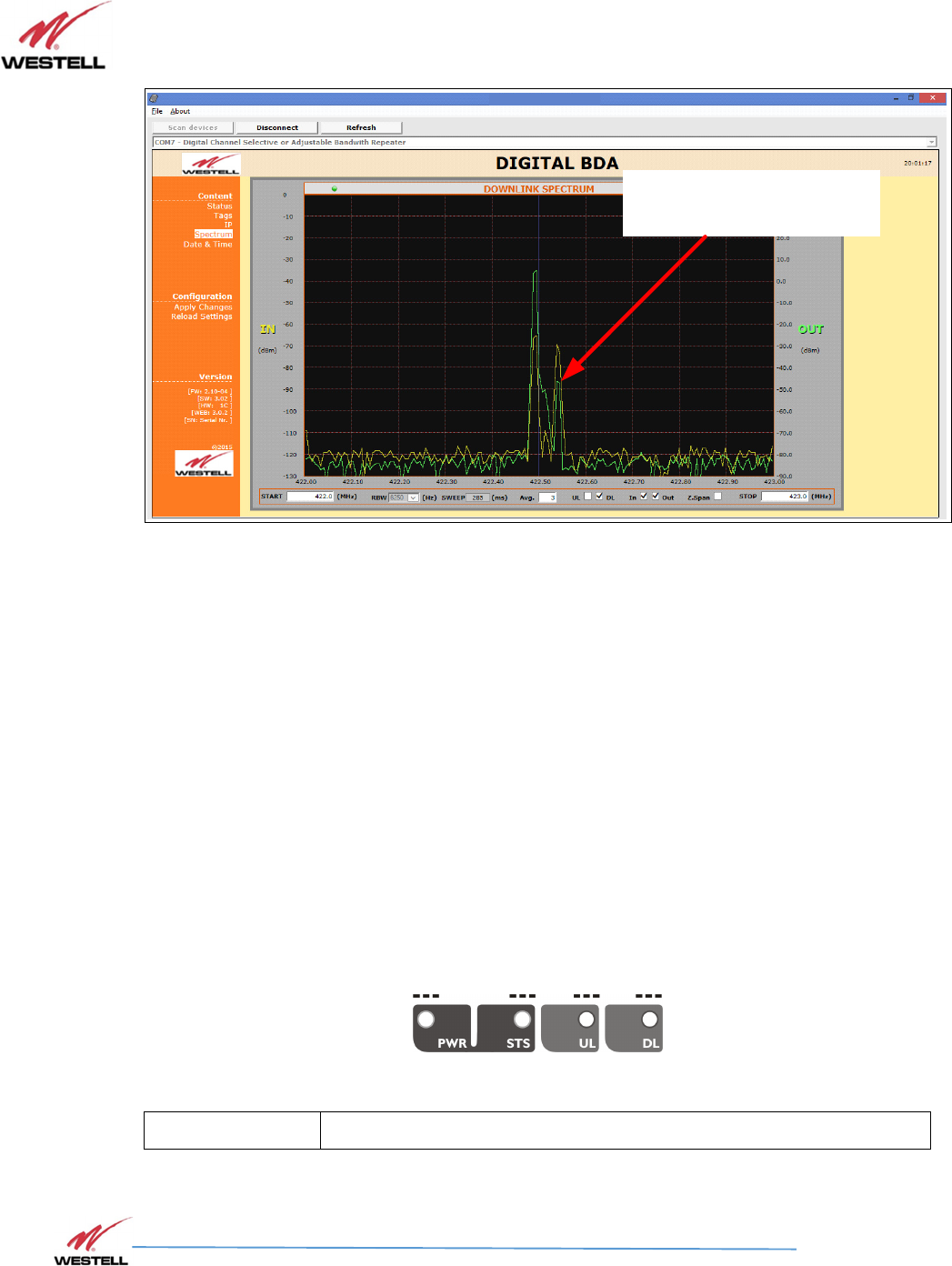
VHF Product Manual
July 2018, Rev B
WESTELL.COM
©2017 Westell Technologies July 2018; Doc No. VHF Signal Booster UM RA
1.877.844.4274 Page 47 of 95
Rejected adjacent channel
with 20KHz filter
Adjacent channel rejection with 20KHz filter
8 Status Indicators
There is an indicator panel located at bottom of the Signal Boosters. This LED panel works as a
status monitor, in order indicate warning or alarms of Signal Booster.
The LED panel has four LEDs, the first one the power ON indication led, labelled “PWR”.
The Second LED, labelled “STS” summarizes warnings regarding critical operational conditions of
the Signal Booster.
The third and fourth LED summarizes operational conditions for uplink “UL” and downlink “DL”
chains.
In general, the LEDs have four states: “off”, “slow blinking”, “fast blinking” and “on”. Next table
describes alarm and warning conditions for each led state.
Indicator Panel LED indication description